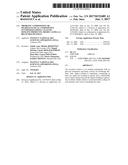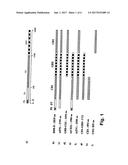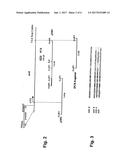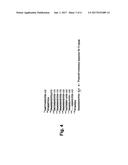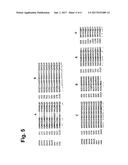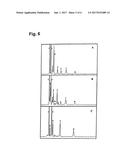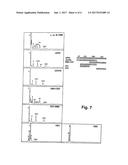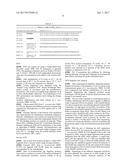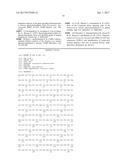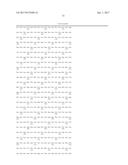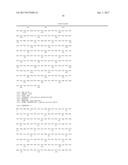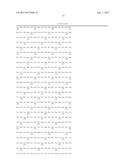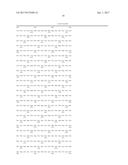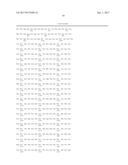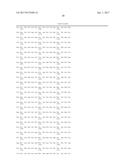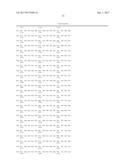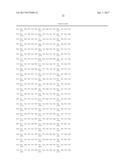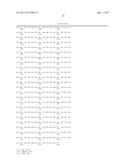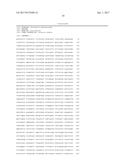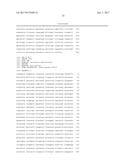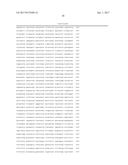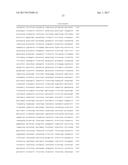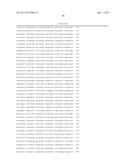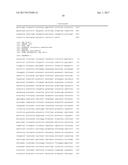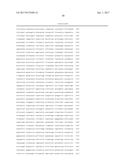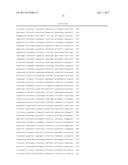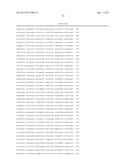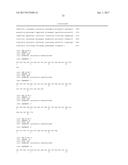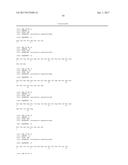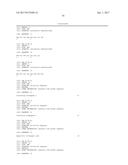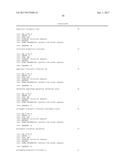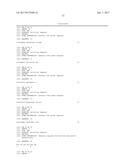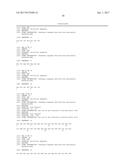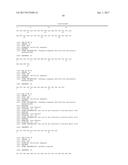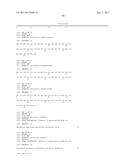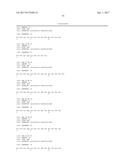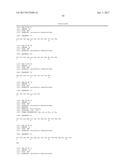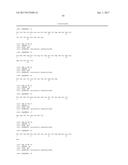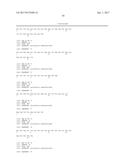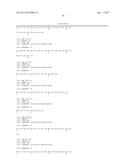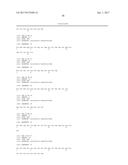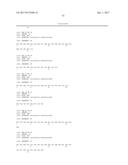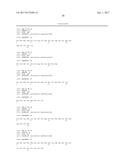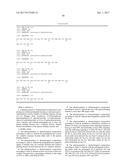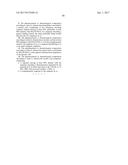Patent application title: Prebiotic composition or pharmaceutical composition synthesized from catalytic domains producing highly alpha-1,2 branched dextran
Inventors:
Sophie Anne Michele Bozonnet (Gagnac-Sur-Garonne, FR)
Magali Martine Claude Remaud-Simeon (Ramonville-Saint-Agne, FR)
Rene-Marc Lucien Willemot (Pompertuzat, FR)
Pierre Emmanuel Frederic Monsan (Mondonville, FR)
Assignees:
INSTITUT NATIONAL DES SCIENCES APPLIQUEES (INSA)
IPC8 Class: AC12N910FI
USPC Class:
1 1
Class name:
Publication date: 2017-06-01
Patent application number: 20170152489
Abstract:
The invention relates to an isolated polypeptide with an glycosyl
transferase enzymatic activity for producing dextrans with
.alpha.(1.fwdarw.2) sidechains, comprising at least one region for
bonding to glucan and a catalytically active region situated beyond the
region bonding to glucan. The invention further relates to
polynucleotides coding for said enzymes and vectors containing the same.Claims:
1. A pharmaceutical or dermatological composition comprising an isolated
polypeptide having an enzymatic glycosyltransferase activity capable of
forming dextrans having .alpha.(1.fwdarw.2) linkages from saccharose,
.alpha.-D-fluoroglucose, paranitrophenyl-.alpha.-D glucopyranoside,
.alpha.-D-glucopyranoside-.alpha.-D sorbofuranoside or 4-O-.alpha.-D
galactopyranosylsucrose, wherein said isolated polypeptide has at least
one glucan binding domain and a catalytic activity domain located
downstream of the glucan binding domain; and a suitable carrier.
2. The pharmaceutical or dermatological composition according to claim 1, wherein the polypeptide has at least two catalytic domains located either side of the glucan binding domain.
3. The pharmaceutical or dermatological composition according to claim 1, wherein the polypeptide has a peptide signal, a variable zone, two catalytic domains and a glucan binding domain located between the two catalytic domains.
4. The pharmaceutical or dermatological composition according to claim 2, wherein at least one of the at least two catalytic domains have a percentage similarity in the range of 65% to 100% with SEQ ID NO:1.
5. The pharmaceutical or dermatological composition according to claim 1, wherein the size of the glucan binding domain is more than 500 amino acids.
6. The pharmaceutical or dermatological composition according to claim 5, wherein the polypeptide contains SEQ ID NO:2.
7. The pharmaceutical or dermatological composition according to claim 6, modified by substitution, insertion or deletion of amino acid sequences and comprising sequences having at least 80% and preferably at least 90% similarity with the following sequences of SEQ ID NO.2: 423-439 (SEQ ID No:6) 2120-2138 (SEQ ID No:12) 478-501 (SEQ ID No:7) 2161-2184 (SEQ ID No:13) 519-539 (SEQ ID No:8) 2202-2214 (SEQ ID No:14) 560-571 (SEQ ID No:9) 2243-2250 (SEQ ID No:15) 631-645 (SEQ ID No:10) 2315-2322(SEQ ID No:16) 1014-1021 (SEQ ID No:11) 2689-2696(SEQ ID No:17).
8. The pharmaceutical or dermatological composition according to claim 7, wherein with the polypeptide, following amino acids are unchanged: W in positions 425 and 2122; E in positions 430, 565 and 2127, 2248; D in positions 487, 489, 527, 638, 2170, 2172, 2210 and 2322;H in position 637 and 2321;Q in position 1019 and 2694.
9. The pharmaceutical or dermatological composition according to claim 1, wherein the polypeptide is encoded by a nucleic acid, comprising: a) two sequences encoding catalytic domains having at least 50%, preferably at least 80% identity with SEQ ID NO:3; b) a sequence encoding a glucan binding domain, the latter preferably being located between the two sequences in a).
10. The pharmaceutical or dermatological composition according to claim 1, wherein the a) nucleic acid has at least 80% identitity with SEQ ID NO: 4; or b) the complementary strand to the sequence in a); or a sequence hybridizing to a) or b) under stringent conditions.
11. The pharmaceutical or dermatological composition according to claim 2, wherein the nucleic acid is constituted by SEQ ID NO:4; or the sequence deduced from degeneracy of the genetic code.
12. The pharmaceutical or dermatological composition according to claim 1, wherein the nucleic acid comprises: comprising: a. a sequence having at least 80% identity with the sequence encoding a dextransucrase expressed by the plasmid pCR-Ty-dsrD deposited at the CNCM on 15 Mar. 2001 with accession number 1-2649; or b. a complementary sequence to the sequence in a).
Description:
[0001] This application is a Divisional of co-pending application Ser. No.
14/278,875, filed May 15, 2014, which is a Divisional of application Ser.
No. 12/213,839, filed on Jun. 25, 2008, (now U.S. Pat. No. 8,758,744 B2)
which is a Divisional of application Ser. No. 10/509,024, filed on Sep.
27, 2004, (now U.S. Pat. No. 7,439,049) which is a Continuation
application of PCT/FR02/00951, filed on Mar. 18, 2002 and for which
priority is claimed under 35 U.S.C. .sctn.120; and this application
claims priority of Application No. 0103631 filed in France on Mar. 16,
2001 and Application No. 0116495 filed in France on Dec. 19, 2001 under
35 U.S.C. .sctn.119; the entire contents of which are all hereby
incorporated by reference.
[0002] The present invention relates to the field of glycotechnology, more particularly to the synthesis of oligosaccharides or oligosides with a prebiotic, therapeutic or diagnostic effect.
[0003] The present invention pertains to nucleic acid molecules encoding an enzyme having a glycosyltransferase activity catalyzing the synthesis of dextrans or oligosides carrying .alpha.(1.fwdarw.2) osidic type linkages.
[0004] The invention also pertains to enzymes synthesized by the nucleic acids of the invention, and to their expression systems in prokaryotic or eukaryotic cells. Finally, they pertain to the use of said enzymes in the production of oligosaccharides in foodstuffs, or as an active principle in therapeutic and/or cosmetic products.
[0005] Oligosides and heterooligosides act as recognition and effector signals in both animals and plants (as oligosaccharines) by specifically binding to lectins, glycosyltransferases, glycosidases, adhesion molecules etc. The antigenic determinants of blood groups are osidics and our defense against many pathogenic bacteria is directed against osidic structures of the bacterial envelope. Further, one of the major reasons for xenograft rejection is the existence of osidic structures belonging to each species. Such properties, and the knowledge acquired in recent years regarding glycosyltransferases and lectins, contribute to making certain oligosides the candidates of choice for therapeutic or prophylactic treatment of disorders linked to the microbiological equilibrium of various organs such as the intestine or skin. As an example, oligosides constitute an interesting alternative to the use of micro-organisms and antibiotics in regulating the composition of intestinal flora (prebiotic effect). Certain oligosides can be considered to be "soluble fiber" when they are not metabolized by human and animal digestive enzymes; on reaching the colon, they interact with the microbial flora and specifically affect the growth and adhesion of certain species. If they are incorporated into food in low doses (less than 1%), certain osidic molecules improve health and stimulate weight gain in animals.
[0006] A review of different glycosyltransferases, their structure and their activity, has been carried out by Vincent Monchois et al (1). Briefly:
[0007] a) it appears that the structure of the glycosyltransferases and/or dextransucrases studied is highly conserved and is constituted, starting from the amino part of the protein, by a signal sequence, a variable domain, a catalytic domain and a glucan binding domain.
[0008] b) glucooligosides (GOS) can be synthesized by glycosyltransferases such as dextransucrases from cheaper substrates such as saccharose and in the presence of a glucose accepting sugar. Other substrates such as .alpha.-D-fluoroglucose, para-nitrophenyl-.alpha.-D-glucopyranoside, .alpha.-D-glucopyranoside-.alpha.-D-sorbofuranoside or 4-O-.alpha.-D-galactopyranosylsucrose can also be used.
[0009] Starting from the substrate, such enzymes catalyze the transfer of glucose units onto acceptor molecules. In the presence of a glucose acceptor such as maltose or isomaltose, glycosyltransferases catalyze the synthesis of low molecular weight oligosaccharides primarily comprising chains with 3 to 7 glucoses, in accordance with the reaction:
Saccharose+acceptor.fwdarw.glucosylated acceptor+fructose
[0010] In such cases, enzymes generally have a specificity for the synthesis of osidic bonds in accordance with that forming the donor polymer.
[0011] In contrast, in the absence of an acceptor, the enzyme synthesizes high molecular weight dextran type glucans by successive transfer of .alpha.-D-glucopyranosyl units from saccharose in accordance with the reaction:
n-saccharose.fwdarw.(glucose).sub.n+n-fructose
[0012] c) The structures and function of glucans or oligosides synthesized by glycosyltransferases depends on the producing bacterial strain.
[0013] Throughout the present text, the generic term "glycosyltransferases" is used to designate the different enzymes capable of catalyzing the synthesis of glucose polymers from saccharose. They are generally produced by bacterial strains of the Leuconostoc, Lactococcus, Streptococcus or Neisseria type. The size and structure of the glucans produced depends on the producing strain.
[0014] The glucose units are coupled by .alpha.(1.fwdarw.6) osidic bonds as in dextran, by .alpha.(1.fwdarw.3) bonds as in the case of mutane, or by alternations of the two types (alternane).
[0015] Similarly, the existence and nature of the linkages, their length and position varies depending on the origin of the producing strain.
[0016] Glycosyltransferases producing glucans or GOSs containing at least 50% .alpha.(1.fwdarw.6) bonds are termed dextransucrases. GOSs synthesized by said enzymes may carry .alpha.(1.fwdarw.2), .alpha.(1.fwdarw.3) and/or .alpha.(1.fwdarw.4) linkages. Said dextransucrases are produced by Leuconostoc mesenteroides type bacteria.
[0017] d) The dextransucrase from L. mesenteroides NRRL B-1299 can produce a highly branched dextran the majority of linkages of which are of the .alpha.(1.fwdarw.2) type. Used in the presence of saccharose and maltose, a glucose acceptor molecule, it results in the formation of GOS some of which have a .alpha.(1.fwdarw.2) bond at their non-reducing end and others of which have .alpha.(1.fwdarw.2) linkages on intermediate residues between the ends. For this reason, they resist degradation by enzymes (hydrolases) of the upper digestive tract in man and animals, and are only degraded by bacterial genuses that are capable of fermenting, such as Bacteroides and Bifidobacterium, considered to be beneficial to the host organism.
[0018] An identical phenomenon occurs in the skin, allowing cosmetic applications to be envisaged, since a lack of equilibrium of the cutaneous microbial flora is the root of numerous cosmetic and dermatological problems. For these reasons, they are designated "GOS of interest" in the present text.
[0019] Throughout the text, polysaccharides synthesized by the glycosyltransferases of the invention are either high molecular weight dextrans when the reaction is carried out without a glucose acceptor, or oligosides when the reaction is carried out in the presence of a glucose acceptor such as maltose or isomaltose without this necessarily being specified. The functionality of the enzyme is characterized by the nature of the glucose-glucose bonds, [.alpha.(1.fwdarw.6), .alpha.(1.fwdarw.2)] or others, and not by the molecular weight of the polysaccharide that is synthesized.
[0020] dextransucrases from L. mesenteroides already have a number of applications in industry, and in particular those from the NRRL B-1299 strain for which a method for synthesizing GOSs having .alpha.(1.fwdarw.2) linkages has been described in European patent EP-B1-0 325 872.
[0021] Marguerite Dols et al (2) showed that the GOS produced dextransucrases from that strain are in fact a mixture of at least three similar families of molecules differing by the number and position of the .alpha.(1.fwdarw.2) type linkages, which leads to the hypothesis that different glycosyltransferase type enzymatic activities exist in that bacterial strain.
[0022] Because of the industrial interest pertaining to GOSs with all .alpha.(1.fwdarw.2) linkages as summarized above in the field of prebiotic foodstuffs, in cosmetics or in pharmaceuticals, the present invention aims to isolate and characterize a particular enzyme from among those produced by L mesenteroides NRRL B-1299 which more particularly would be involved in the synthesis of oligosides having .alpha.(1.fwdarw.2) linkages. The identification and characterization of such an enzyme have the advantage firstly of providing a uniform, reproducible method for producing GOSs of interest and secondly of identifying the essential characteristics of the producer enzyme for said GOSs of interest in order, if appropriate, to improve the performance of the products of the enzymatic reaction as a function of the envisaged use.
[0023] The technical problem underlying the present invention is thus to provide an enzyme and hence isolated nucleic acids encoding said enzyme to allow the improved production of GOS having .alpha.(1.fwdarw.2) linkages.
[0024] The present invention provides a technical solution to the various questions mentioned above by providing a novel dextransucrase, termed DSR-E, encoded by a gene endowed with a novel and unexpected structure (dsrE) capable of catalyzing the synthesis of glucans or oligosaccharides containing .alpha.(1.fwdarw.2) linkages.
[0025] Between the date of filing of the priority document, French patent number 0103631 in which the dextransucrase of the invention was termed DSR-D, and that of the present application, another dextransucrase, different from the enzyme of the invention, was described and also termed DSR-D. For this reason, in the present patent application, the dextransucrase described, claimed and shown in FIG. 1b) is no longer designated DSR-D as in the priority document, but is termed DSR-E. In fact, the DSR-D dextransucrases in said priority document and DSR-E are completely identical.
[0026] The term "novel and unexpected structure" means that the organization of the protein differs from that of all other glycosyltransferases described until now (1) with a catalytic domain located upstream of a glucan binding domain, the latter constituting the carboxylic portion of the protein.
[0027] The present invention thus concerns an isolated polypeptide having an enzymatic glycosyltransferase activity capable of forming dextrans having .alpha.(1.fwdarw.2) linkages, characterized in that it comprises at least one glucan binding domain and a catalytic activity domain located downstream of the glucan binding domain. The term "located downstream" means the fact that the amine portion of the sequence with catalytic activity or catalytic domain is proximal to the carboxylic portion of the glucan binding domain. These two domains can be immediately contiguous or, in contrast, they may be separated by a variable domain.
[0028] The glycosyltransferase of the invention preferably comprises a signal peptide.
[0029] In one implementation of the invention, the glycosyltransferase comprises two catalytic domains located either side of the glucan binding domain.
[0030] The presence of a domain with catalytic activity in the carboxylic portion of the enzyme is an essential characteristic of the latter in its capacity to form osidic .alpha.(1.fwdarw.2) bonds. In fact, as will be shown in the experiments described below, deletion of this domain in an enzyme having at least two catalytic domains results in the production of glucans or oligosides essentially having .alpha.(1.fwdarw.6) type osidic bonds and free of .alpha.(1.fwdarw.2) type bonds.
[0031] More precisely, the catalytic domain, as long as it is located downstream of a glucan binding domain, allows the synthesis of oligosides containing .alpha.(1.fwdarw.2) bonds.
[0032] Further, the experiments described below demonstrate that the specificity of the dextransucrase DSR-E function, namely its capacity to catalyze the formation of .alpha.(1.fwdarw.2) osidic bonds, can be attributed not to the concomitant presence of two catalytic domains but rather to the concatenation of a glucan binding domain and a catalytic domain, and more particularly the CD2 catalytic domain.
[0033] A comparative analysis of the different glycosyltransferases including dextransucrases has demonstrated a very high degree of conservation of their catalytic domain.
[0034] The catalytic domain located in the carboxy-terminal portion of the glycosyltransferase of the invention has a sequence having at least 44% identity and 55% similarity with the catalytic domains of the other analyzed glycosyltransferases. In particular, the catalytic domain in the carboxylic portion of the glycosyltransferase of the invention has at least 65% identity and at least 80% similarity with the SEQ ID No: 1, the catalytic triad Asp/Glu/Asp in respective positions 230/268/342 being conserved.
[0035] Throughout the text, the term "X %" similarity" with respect to a reference sequence means that X % of the amino acids are identical or modified by conservative substitution as defined in the ClustalW amino acid alignment software (http:///bioweb.pasteur.fr/docs/doc-gensoft/clustalw//) and that (100-X)% can be deleted, substituted by other amino acids, or that (100-X)% can be added to the reference sequence. A particular primary structure of the enzyme of the invention is shown in SEQ ID No: 2 which represent a sequence of 2835 amino acids of a dextransucrase of L. mesenteroides NRRL B-1299.
[0036] This dextransucrase, denoted DSR-E, like most glycosyltransferases and dextransucrases, has a signal sequence, a variable domain of low conservation, a highly conserved catalytic domain (CD1), a glucan binding domain (GBD) and a second catalytic domain (CD2) in the carboxylic portion of the protein. DSR-E is the first glycosyltransferase analyzed and has two catalytic domains, in the configuration shown in FIG. 1b). It is also the first glycosyltransferase the catalytic domain of which is located in the carboxylic portion of the protein.
[0037] FIG. 1b) also shows that the glucan binding domain is substantially longer than that described above for known dextransucrases; thus, a further characteristic of the enzymes of the invention is the size of this domain which is over 500 amino acids.
[0038] A comparison and analysis of the DSR-E sequence with the sequences of the glycosyltransferases or dextransucrases that have already been described (1), and the means used to this end are indicated in Example 2 detailed below. It clearly shows that while the existence of two catalytic domains substantially differentiates DSR-E from other enzymes, in contrast the sequences of said domains are substantially conserved. In particular, the amino acids necessary for catalytic activity are conserved in the second catalytic domain, namely the triad Asp/Glu/Asp located in respective positions 2210/2248/2322 of SEQ ID No: 2.
[0039] Thus, the invention also concerns any isolated polypeptide having a catalytic glycosyltransferase activity that is capable of forming dextrans or oligosaccharides having .alpha.(1.fwdarw.2) linkages as obtained by modification, substitution, insertion or deletion of amino acid sequences but comprising sequences having at least 80% and preferably at least 90% similarity with the following sequences of SEQ ID No: 2:
TABLE-US-00001 423-439 478-501 519-539 560-571 631-645 1014-1021 2120-2138 2161-2184 2202-2214 2243-2250 2315-2322 2689-2696
[0040] Preferably, finally, a polypeptide with catalytic activity of the invention contains the following amino acids:
[0041] W in positions 425 and 2122;
[0042] E in positions 430, 565 and 2127, 2248;
[0043] D in positions 487, 489, 527, 638, 2170, 2172, 2210 and 2322;
[0044] H in position 637 and 2321;
[0045] Q in position 1019 and 2694.
[0046] The polypeptides with glycosyltransferase activity that can form osidic .alpha.(1.fwdarw.2) bonds can be in the isolated form or, in contrast, integrated into a larger protein such as a fusion protein. It may be advantageous to include sequences having another function, such as a specific tag sequence of a ligand that can facilitate purification. These tag sequences can be of the following types: GST (glutathione-S-transferase), intein-CBD (chitin-binding domain) (sold by New England Biolabs, http://www.neb.com), MBD (maltose binding domain), polypeptides containing contiguous histidine residues that can facilitate purification of the polypeptide with which it is fused. The skilled person could design any other fusion protein that could associate the function of the DSR-E of the invention with another function, a non limiting example being a sequence increasing the stability of the enzyme produced by expression in a recombinant host or a sequence that can increase the specificity or efficacy of action of said enzyme, or a sequence aimed at associating another connected enzymatic activity.
[0047] Such fusion proteins also fall within the scope of the invention provided that they contain the CD2 domain of the glucan binding site. In the same manner, fragments of SEQ ID No: 2, comprising at least SEQ ID No: 1 and the glucan binding domain, alone or integrated into a larger polypeptide forms part of the invention, as long as the enzymatic activity of the dextransucrase is conserved.
[0048] Variations of the polypeptide sequences defined above also form part of the invention. In addition to the polypeptides obtained by conservative substitution of the amino acids defined above, the variations include polypeptides the enzymatic activity of which is improved, for example by directed or random mutagenesis, by DNA shuffling, or by duplication of the CD2 catalytic domain.
[0049] The particular structure of this enzyme identified in the present invention results from a process comprising:
[0050] a) identifying and isolating dextransucrase from L mesenteroides catalyzing the production of GOSs of interest carrying .alpha.(1.fwdarw.2) linkages;
[0051] b) sequencing the enzyme fragments;
[0052] c) synthesizing amplification primers that can amplify the gene corresponding to the producing strain or fragments thereof;
[0053] d) sequencing the amplified fragments;
[0054] e) cloning in specific vectors and their expression in appropriate hosts.
[0055] The features of the method employed are given in detail in the experimental section below. The first step consists of separating the proteins by polyacrylamide gel electrophoresis and identifying bands having a dextransucrase activity by an in situ enzymatic reaction in the presence of substrate and acceptor. The nature of the GOSs synthesized is then identified for each band by HPLC analysis using the methods described in (1). The retention time for the oligosides in HPLC depends on the nature and organization of their osidic bonds. In particular, it is possible to distinguish between those constituted by residues having .alpha.(1.fwdarw.6) bonds, having .alpha.(1.fwdarw.6) bonds with a .alpha.(1.fwdarw.2) linkage at the nonreducing end of the molecule, and the desired compounds having a linear .alpha.(1.fwdarw.6) chain with .alpha.(1.fwdarw.2) linkages.
[0056] The inventors therefore isolated and identified dextransucrase from L. mesenteroides NRRL B-1299 producing GOSs of interest.
[0057] A reverse engineering process carried out in steps b) to e) above then provide the nucleotide sequence encoding the enzyme, allowing industrial scale production and, if appropriate, allowing it to be modified, improving its performance using techniques that are available to the skilled person. As an example, directed or random mutagenesis or DNA shuffling can be cited (3).
[0058] The invention also pertains to an isolated nucleic acid molecule encoding an enzyme with glycosyltransferase activity that can form dextrans or oligosides having .alpha.(1.fwdarw.2) linkages and comprising at least one sequence encoding a glucan binding domain, and at least one nucleotide sequence encoding a catalytic domain located on the 3' side of the foregoing, said sequence encoding a catalytic domain having at least 50% and preferably at least 70% similarity with SEQ ID No: 3.
[0059] The term "similarity" means that for the same reading frame, a given triplet is translated by the same amino acid. Thus, this term includes modifications to bases resulting in degeneracy of the genetic code.
[0060] The percentage similarity is determined by comparing a given sequence with the reference sequence. When they have different lengths, the percentage similarity is based on the percentage of nucleotides in the shortest sequence which are similar to those in the longest sequence.
[0061] The degree of similarity can be conventionally determined using software such as ClustalW (Thompson et al, Nucleic Acid Research (1994), 22: 4673-4680) distributed by Julie Thompson (Thompson@EMBL-Heidelberg.de) and Toby Gibson (Gibson@EMBL-Heidelberg.de) at the European Molecular Biology Laboratory, Meyerhofstrasse 1, D-69117, Heidelberg, Germany. ClustalW can also be downloaded from a number of websites including IGBMC (Institut de Genetique et de Biologie Moleculaire et Cellulaire, B P 163, 67404 Illkirch Cedex, France; ftp://ftp-igbmc.u-strabg.fr/pub/) and EBI (ftp://ftp.ebi/ac.uk/pub/software/) and all sites linking to the Bioinformatics Institute (Wellcome Trust Genome Campus, Hinxton, Cambridge, CB10 1SD, UK).
[0062] The isolated nucleic acids of the invention can in particular comprise other sequences intended to improve the expression and/or activity of the enzyme produced.
[0063] As an example, they can be:
[0064] sequences encoding a signal sequence for their secretion;
[0065] duplication of the sequence encoding the CD2 catalytic domain.
[0066] Preferably, an isolated nucleic acid of the invention comprises:
[0067] a) two sequences encoding catalytic domains having at least 50%, preferably at least 80% similarity with SEQ ID No: 3;
[0068] b) a sequence enclosing the glucan binding domain, the latter preferably being located between the two sequences in a).
[0069] A nucleic acid of the invention can also comprise:
[0070] a promoter suitable for its expression in a selected host cell;
[0071] a sequence encoding a signal peptide; and/or
[0072] one or more variable sequences;
[0073] said sequence or sequences all being located in the 5' portion of sequences encoding the catalytic domain(s).
[0074] A more particular example of an isolated nucleic acid of the invention comprises:
[0075] a) SEQ ID No: 4;
[0076] b) a sequence having at least 80% similarity with SEQ ID No: 4; or
[0077] c) the complementary strand to sequence a) or b); or
[0078] d) a sequence hybridizing a), b) or c).
[0079] The hybridization in d) is carried out under standard conditions, and preferably under stringent conditions. The term "hybridization under stringent conditions" means that there is at least 80% sequence identity with the sequence which is to be hybridized, preferably an identity of at least 90% of the sequence which is to be hybridized, under conditions which are, for example, described in Sambrook and Russel (3.sup.rd edition, 2001, Cold Spring Harbor Laboratory Press, Cold Spring Harbor, N.Y.).
[0080] The invention also concerns a gene encoding a dextransucrase that can form at least 15% .alpha.(1.fwdarw.2) linkages. In addition to the encoding sequence, the gene comprises sequences that allow transcription initiation and sequences that allow attachment of messenger RNA to the ribosome (RBS). SEQ ID No: 5 represents a gene structure as isolated from L. mesenteroides NRRL B-1299.
[0081] The nucleotides upstream of the translation initiation ATG are numbered 1 to 232.
[0082] The existence of a RBS sequence can be identified between nucleotides 218 and 223 as well as the consensus sequences -35 and -10 located between nucleotides 82 and 86 (TTGAA) on the one hand and 100 and 105 (ATAAAT) on the other hand.
[0083] Any nucleic acid sequence that can be hybridized with DNA of SEQ ID No: 4 or its complementary strand is capable of encoding an enzyme having the properties and characteristics of the enzyme of the invention. This applies to natural sequences existing in micro-organisms other than L. mesenteroides NRRL B-1299 and isolated from gene libraries of micro-organisms, and to those prepared by genetic engineering or by chemical synthesis.
[0084] In particular, the sequences upstream of the translation initiation ATG and necessary for expression of the protein can advantageously be substituted by transcription initiation and/or ribosome binding sequences suitable for the expression system selected for the coding sequence.
[0085] A nucleic acid sequence that is capable of hybridizing under stringent conditions with the isolated nucleic acid of the invention also comprises fragments, derivatives or allele variations of the nucleic acid sequence of the invention which encodes a protein having the enzymatic activity described above. Thus, the fragments are defined as fragments of nucleic acid molecules that are sufficiently long to encode a protein that has conserved its enzymatic activity. This also encompasses fragments that are free of the sequence encoding the signal peptide responsible for protein secretion.
[0086] The term "derivative" means a sequence that is different from the original sequence in one or more positions but which has a high degree of similarity with said sequences. In this context, "similarity" means at least 80% identity of the nucleotides, preferably at least 90% identity with the original sequence. The modifications in this case are deletions, substitutions, insertions or recombinations provided that the enzyme encoded by these homologous sequences has the enzymatic activity of the polypeptides of the invention.
[0087] The nucleic acid sequences of the invention as described above and qualified by derivatives of said molecules as defined above are generally variations exerting the same biological function. Said variations can be natural variations, in particular those observed from one species to another and resulting in interspecies variability or, in contrast, those introduced via directed or random mutagenesis or by DNA shuffling.
[0088] Similarly, the invention encompasses isolated nucleic acids encoding a glycosyltransferase that can catalyze the synthesis of dextran or oligosaccharide carrying at least 20% and preferably at least 30% type .alpha.(1.fwdarw.2) linkages obtained by DNA shuffling and comprising:
[0089] a step for random modification of one of the sequences defined above and in particular SEQ ID Nos: 3 and 4 and establishing the variations;
[0090] a step for expressing a host housing a variation from said modified sequences in a suitable host cell;
[0091] a step for screening hosts expressing an enzyme that can form more than 20% and preferably more than 30% .alpha.(1.fwdarw.2) bonds on a suitable substrate and a step for isolating the improved gene or genes.
[0092] An isolated nucleic acid of the invention can also comprise:
[0093] a) a sequence containing at least 80% similarity with the sequence encoding a dextransucrase expressed by the plasmid pCR-T7-dsrE in E. coli deposited at the CNCM on 15 Mar. 2001 with accession number I-2649 (E. coli JM 109 [pCR-T7-dsrD]), or
[0094] b) a complementary sequence of the sequence in a).
[0095] The denomination of the strain transformed by the recombinant plasmid pCR-T7-dsrE deposited at the CNCM is that indicated above in brackets. This does not affect the change in the denomination of the gene carried out following deposition of said strain for the reasons given above.
[0096] The invention also concerns nucleic acid fragments as defined above, which are hybridizable with SEQ ID No: 4 and can be used as hybridization probes for detecting sequences encoding the enzymes of the invention. Said fragments can be prepared using any technique known to the skilled person.
[0097] In addition to hybridization probes, amplification primers also form part of the invention. Said primers are fragments which are hybridizable with SEQ ID No: 4 or with its complementary strand and which allow amplification of specific sequences encoding dextransucrases present in a prokaryotic or eukaryotic animal or plant organism.
[0098] The use of said amplification primers allows the use of a method for identifying the possible existence of a gene encoding an enzyme that can catalyze synthesis of GOS with .alpha.(1.fwdarw.2) linkages in said organism, said method also forming part of the invention.
[0099] The invention also concerns expression vectors comprising a nucleic acid as described above under the control of a sequence allowing its expression and preferably its excretion in prokaryotic or eukaryotic cells. The term "prokaryotic cells" preferably denotes bacteria selected from a group comprising E. coli, Lactococcus, Bacillus and Leuconostoc. The term "eukaryotic cells" preferably means eukaryotes selected from a group containing yeasts, fungi and plants.
[0100] The vector comprises a promoter suitable for expression of the isolated nucleic acid of the invention in the selected expression system. As an example, the T7 bacteriophage promoter could advantageously be selected for expression in E. coli.
[0101] The invention also concerns host cells, prokaryotic or eukaryotic, transformed by a nucleic acid of the invention, preferably comprised in an expression vector carrying a promoter, adapted for expression in the selected host cells. The transformed cells are selected from Gram-bacteria such as E. coli, or from Gram+ bacteria such as Lactococcus, Bacillus, Leuconostoc, or from eukaryotes in a group comprising yeasts, fungi and plants.
[0102] One particular example of a cell transformed in accordance with the invention is the E. coli strain harboring a plasmid termed pCR-T7-dsrE carrying the SEQ ID No: 4 under the control of the T7 bacteriophage promoter deposited at the CNCM on 15 Mar. 2001 under accession number 1-2649.
[0103] The present invention also concerns a method for producing a glycosyltransferase that can form dextrans or oligosides having at least 15% and preferably at least 20% of type .alpha.(1.fwdarw.2) osidic linkages and comprising:
[0104] a) inserting a nucleic acid or a vector as defined above into a host cell that can express and preferably secrete the glycosyltransferase;
[0105] b) characterizing the enzymatic activity being investigated using any of the methods accessible to the skilled person;
[0106] c) purifying the enzyme from a cell extract.
[0107] The term "method for characterizing enzymatic activity known to the skilled person" means the methods described in the literature, for example in reference (2), and novel methods that may be developed to allow identification and discrimination of glucooligosaccharides having the desired degree of linkages.
[0108] In fact, it concerns any screening method that can identify the presence of .alpha.(1.fwdarw.2) linkages in a GOS.
[0109] Examples are:
[0110] HPLC in which GOS migration varies as a function of the nature and position of the linkages, in particular those containing the .alpha.(1.fwdarw.2) bond at the reducing end and those containing this bond on the penultimate glucose; and/or
[0111] nuclear magnetic resonance (NMR);
[0112] the existence of a positive reaction with specific monoclonal antibodies of .alpha.(1.fwdarw.2) bonds on the reducing end and/or specific monoclonal antibodies of .alpha.(1.fwdarw.2) bonds on the penultimate glucose of the GOS.
[0113] The invention also concerns a method for obtaining a glycosyltransferase that can have oligosides or dextrans having a percentage of .alpha.(1.fwdarw.2) linkages of more than 15% and preferably more than 30% of the totality of the osidic bonds and comprising a step for modifying SEQ ID No: 4 by addition, deletion or mutation provided that:
[0114] the reading frame is not modified; and
[0115] the following amino acids are conserved after translation:
[0116] W in positions 425 or 2122, encoded by the TGG triplet in positions 1273 and 6364;
[0117] E in positions 430, 565, 2127 and 2248, encoded by GAA triplets in positions 1288, 1693, 6379 and 6742 respectively;
[0118] D in positions 487, 489, 527, 638, 2170 and 2210, encoded by GAT triplets in positions 1459, 1465, 1579, 1912, 6508 and 6628 respectively;
[0119] D in positions 2172 and 2322 encoded by GAT triplets in positions 6514 and 6964;
[0120] H in position 637 and 2321, respectively encoded by the CAT triplet in position 1909 and CAC in position 6961;
[0121] Q in positions 1019 and 2694, respectively encoded by triplets CAA (position 3055) and CAG (position 8080).
[0122] A method for producing a glycosyltransferase according to the invention having the same characteristics as above can also comprise:
[0123] a step for randomly modifying SEQ ID No: 4 and establishing a library of variations;
[0124] a step for expressing a host housing a variation from said modified sequences in a suitable host cell;
[0125] a step for screening hosts expressing an enzyme that can form more than 15% and preferably more than 30% of .alpha.(1.fwdarw.2) bonds on a suitable substrate;
[0126] and a step for isolating the improved gene or genes.
[0127] In a further implementation of the invention, the method consists of modifying SEQ ID No: 3 by duplicating all or part of the CD2 catalytic domain.
[0128] It should be understood that the methods above are not only aimed at obtaining a glycosyltransferase that can form oligosides having a constant and reproducible percentage of .alpha.(1.fwdarw.2) linkages of more than 15% of the total linkages, but also to improve the degree of .alpha.(1.fwdarw.2) linkages with the aim of modifying the properties of the oligosides obtained to improve their dietetic properties or their capacity to maintain or re-establish bacterial flora associated with certain organs of the human or animal body.
[0129] Finally, the present invention concerns glycosyltransferases that can be obtained by a method as defined above and which can form at least 15% and preferably at least 30% of type .alpha.(1.fwdarw.2) osidic linkages in glucooligosaccharides.
[0130] Finally, the invention pertains to the use of glycosyltransferases of the invention as well as those that can be obtained by the methods mentioned above, in the production of a composition with a pre-biotic effect or in the manufacture of a dermatological, cosmetic or pharmaceutical composition.
[0131] Non-limiting examples that can be cited are the improvement in intestinal transit in animals and in man, an improvement in calcium and/or magnesium assimilation and of minerals in general, preventing cancer of the colon and prevention or treatment of skin affections such as acne, dandruff or body odor.
[0132] The advantage of the polypeptides and nucleic acids encoding said polypeptides of the invention is not only in improvements in terms of quality, yield, reproducibility and cost of glycosyltransferases that can form oligosaccharides with type .alpha.(1.fwdarw.2) osidic linkages, but also in producing novel enzymes the functionality of which is improved.
[0133] The figures, examples and detailed description below provide non-limiting illustrations of the particular characteristics and functionalities of polypeptides with enzymatic activity and sequences encoding them. In particular, they can illustrate more precisely the specificity of the catalytic domain present in the carboxylic portion of the enzyme of the invention and its potential evolution to obtain improved enzymes.
KEY TO FIGURES
[0134] FIG. 1: Structure of native glycosyltransferases and derived recombinant proteins: FIG. 1a) shows the structure of glycosyltransferases and dextransucrases described in the literature (1). PS: signal peptide; ZV: variable zone; CD: catalytic domain; GBD: glucan binding domain. FIG. 1b) shows the structure of the glycosyltransferase of the invention. FIGS. 1c) to 1i) show different constructions comprising deletions in comparison with native DSR-E protein. .DELTA.(PS) corresponds to the control constituted by the entire form cloned into the pBAD-TOPO thiofusion system (Invitrogen).
[0135] FIG. 2: Diagrammatic summary of the method for cloning the nucleotide sequence encoding a glycosyltransferase of the invention using a genome library by using a PCR probe described in Table I and a HindIII/EcoRV probe respectively.
[0136] FIG. 3: Comparison of the signal sequences of different glycosyltransferases of L. mesenteroides (residues 1-40 of SEQ ID NO: 2). The conserved amino acids are shown in bold. DSR-B: L. mesenteroides NRRL B-1299 (4) (SEQ ID NO: 0.45); DSR-S: L. mesenteroides NRRL B-512F (5) (SEQ ID NO: 46); ASR: L. mesenteroides NRRL B-1355 (6) (SEQ ID NO: 47).
[0137] FIG. 4: Alignment of 11 repeat sequences (SEQ ID NOS: 50-61) of the DSR-E enzyme and observed in the variable zone.
[0138] FIG. 5: Alignment of conserved sequences in the catalytic domain (SEQ ID NOS: 6-17 and 62-103).
[0139] Block A: essential amino acids of the N-terminal portion of the catalytic domain;
[0140] Block B: amino acids of the catalytic saccharose binding domain;
[0141] Blocks C, D, E: blocks containing three amino acid residues involved in the catalytic triad (6);
[0142] Block F: sequence containing glutamine 937 of GTF-1 studied by Monchois et al (7).
[0143] The entirely conserved amino acids are indicated in bold. "*": conservative substitutions; ":": semi-conservative substitutions; ---: gap. The numbering is that for SEQ ID No: 2.
[0144] FIG. 6: HPLC characterization of products synthesized by recombinant enzyme DSR-E.
[0145] 6A: HPLC analysis of glucooligosaccharides obtained with dextransucrases of L. mesenteroides NRRL B-1299.
[0146] 6B: HPLC analysis of glucooligosaccharides obtained by recombinant DSR-E. The following peaks are identified:
[0147] 1: fructose
[0148] 2: maltose;
[0149] 3: sucrose;
[0150] 4: panose;
[0151] 5: R4;
[0152] 6: OD4;
[0153] 7: R5;
[0154] 8: OD5;
[0155] A, B, C: unidentified peaks.
[0156] 6C: recombinant DSR-E deleted from the catalytic domain of the carboxylic portion of the enzyme (.DELTA.DSR-E).
[0157] FIG. 7: HPLC analysis of acceptor on maltose reaction products synthesized by different entire forms and deleted from the DSR-E protein.
[0158] L.m. B-1299: mixture of dextransucrases produced by L. mesenteroides NRRL B-1299.
[0159] The peaks were identified as follows:
[0160] F: fructose;
[0161] M: maltose;
[0162] S: saccharose
[0163] P: panose;
[0164] R4, R5: GOS comprising .alpha.(1.fwdarw.2) bonds;
[0165] OD4, OD5: GOS free of .alpha.(1.fwdarw.2) bonds.
MATERIALS AND METHODS
1) Bacterial Strains, Plasmids and Growth Conditions:
[0166] All strains were kept at -80.degree. C. in tubes containing 15% glycerol (v/v).
[0167] Leuconostoc mesenteroides B-1299 (NRRL, Peoria, USA) was cultivated at 27.degree. C. with stirring (200 rpm) on standard medium (saccharose 40 g/l, potassium phosphate 20 g/l, yeast extract 20 g/I, MgSO.sub.4, 7H.sub.2O 0.2 g/l, MnSO.sub.4, H.sub.2O 0.01 g/l, NaCl 0.01 g/l, CaCl.sub.2 0.02 g/l, FeSO.sub.4, 7H.sub.2O 0.01 g/l), the pH being adjusted to 6.9.
[0168] Escherichia coli DH5.alpha. and JM109 were cultivated on LB medium (Luria-Bertani).
[0169] Selection of pUC18 or pGEM-T Easy recombinant clones was carried out on LB-agar dishes supplemented with 100 .mu.g/ml of ampicillin, 0.5 mM of isopropyl-.beta.-D-thiogalactopyranoside (IPTG) and 40 .mu.g/ml of 5-bromo-4-chloro-3-indolyl-.beta.-D-galactopyranoside (X-gal). E. coli TOP 10 cells were used to clone the PCR TOPO Cloning (Invitrogen) product and cultivated on LB medium supplemented with kanamycin in a concentration of 50 .mu.g/ml.
[0170] Regarding expression of dsrE, the ECHO Cloning System cloning kit (Invitrogen) allows a PCR product to be cloned in a donor vector (pUNI/V5-His-TOPO), preceding a step for recombination with a suitable acceptor vector (pCR-T7-E). This system requires E. coli PYR1, TOP 10 and PL21(DE3)pLysS cells cultivated on LB medium supplemented with 50 .mu.g/ml of kanamycin as well as 34 .mu.g/ml of chloramphenicol for the BL21(DE3)pLysS strain.
[0171] Digested and dephosphorylated pUC18 plasmids from Pharmacia (Amersham Pharmacia Biotech) were used to constitute the genomic DNA library of L. mesenteroides NRRL B-1299. Cloning of the PCR product necessitated the use of the pGEM-T Easy plasmid (Promega) and TOPO-XL plasmid (Invitrogen) for fragments of more than 2 kbp.
[0172] The pBAD-TOPO Thiofusion system (Invitrogen) used to construct the different deleted forms of the DSR-E protein used the araBAD promoter the control mechanisms for which involve the AraC regulatory protein. In the absence of an inducer, namely L-arabinose, the dimeric AraC protein associates with the regulatory structures of the operon and entrains the formation of a DNA loop, said loop then blocking transcription of genes placed under the control of the araBAD promoter. In the presence of L-arabinose, in contrast, AraC forms a complex which liberates the DNA loop and allows transcription initiation. The base expression can be limited by adding glucose to the culture medium: this reduces the level of cyclic AMP and thus concomitant activation of the CAP protein (cAMP activator protein). The level of activation obtained is a function of the concentration of L-arabinose so that the optimum conditions for production of the protein of interest can be selected with accuracy.
[0173] Further, the use of this vector can allow a 12 kDa thioredoxin tag to be positioned on the N-terminal end of the protein of interest. This fusion encourages the translation of the gene encoding said protein of interest. The tag protein can also enhance the solubility of the protein to which it is fused. The pBAD-TOPO Thiofusion system is designed to allow ready elimination of the thioredoxin tag by simple cleavage using enterokinase. Finally, using this expression system, a histidine tag is inserted on the C-terminal end side of the protein of interest. Such a tag is used to purify said protein by affinity.
[0174] Within the context of using this system, the E. coli TOP 10 strain was cultivated on LB medium supplemented with 100 .mu.g/ml of ampicillin.
2) Gel Electrophoresis, Location and Characterization of Enzyme:
[0175] After culturing L. mesenteroides NRRL B-1299 for 7 h, the medium was centrifuged (7000 rpm, 4.degree. C., 30 min) and the cells, in which 90% of the enzymatic activity was found, were concentrated 10 times in an acetate buffer solution (20 mM, pH 5.4), heated for 5 minutes at 95.degree. C. in the presence of denaturing solution (tris HCl 62.5 mM, SDS 4%, urea 6M, bromophenol blue 0.01% and .beta.-mercaptoethanol 200 mM). 300 .mu.l of the mixture was deposited on 7% polyacrylamide gel. After migration, the total proteins were revealed by amido black staining, while the dextransucrase activity was detected by staining with Schiff's reagent polymer after synthesizing the dextran in situ. The bands corresponding to the active dextransucrases were excised and incubated separately in 2 ml of 20 mM sodium acetate solution, pH 5.4, containing 100 g/l of saccharose and 50 g/l of maltose. After total consumption of saccharose, the reaction was stopped by heating to 95.degree. C. for 5 minutes, and the reaction medium was centrifuged for 5 minutes at 15000 g to eliminate the insoluble dextran. The samples were analyzed by reverse phase chromatography (C18 column, Ultrasep 100, 6 .mu.m, 5.times.300 mm, Bishoff Chromatography) using ultrapure water as the eluent, at a constant flow rate of 0.5 ml/min. The oligosaccharides were separated for 30 minutes at ambient temperature and detected by refractometry. Peptide sequencing was carried out on the selected protein bands by the Laboratoire de Microsequencage, Institut Pasteur, Paris.
3) Molecular Biological Techniques Used
[0176] Purification of the E. coli plasmid and purification of the genomic DNA of L. mesenteroides was carried out using the QiaPrep Spin Plasmid kit and the Cell Culture DNA maxi kit (Qiagen) respectively. The amplification and cloning methods were carried out using standard techniques (Sambrook and Russel, 2001, supra). Restriction and modification enzymes from New England Biolabs or Gibco BRL were used in accordance with the manufacturer's instructions.
[0177] PCR was carried out with primers selected on the basis of the protein sequence obtained on an isolated band from gel electrophoresis (see supra, gel electrophoresis and enzyme localization). Two peptides were selected:
TABLE-US-00002 (SEQ ID NO: 18) 29-FYFESGK; and (SEQ ID NO: 19) 24-FESQNNNP
[0178] and used to synthesis degenerate oligonucleotides indicated in Table I below.
[0179] In this table, the numbering of which follows that of SEQ ID No: 4, it appears that the presence of a serine residue in the two peptides necessitates the synthesis of two primers for each peptide since serine can be encoded by six different codons. ECHO-dir and ECHO-inv are primers which allowed amplification of dsrE by PCR for cloning into the ECHO Cloning (Invitrogen) expression system.
TABLE-US-00003 TABLE I Table 1: SEQ ID NOS: 18-27 Designation Description Sequence 5'-3' 29-dir1 FYFESGK TT(C/T)TA(C/T)TT(C/T)GA(A/G)TCAGG(C/G)AA(A/G) 29-dir2 TT(C/T)TA(C/T)TT(C/T)GA(A/G)AGCGG(C/G)AA(A/G) 24-inv1 FESQNNNP (T/G)GG(G/A)TT(G/A)TT(G/A)TTTTGTGA(T/C)TCAAA 24-inv2 (T/G)GG(G/A)TT(G/A)TT(G/A)TTTTGGCT(T/C)TCAAA IPCR-rev sequence nt CCCTTTACAAGCTGATTTTGCTTATCTGCG 5769-5798 IPCR-dir sequence nt GGGTCAAATCCTTACTATACATTGTCACACGG 8311-8342 ECHO-dir sequence nt-6- AGTTGTATGAGAGACATGAGGGTAATTTGTGACCGTAAAAAATTG 39 ECHO-iv sequence nt ATTTGAGGTAATGTTGATTTATCACCATCAAGCTTGAAATATTGACC 8457-8504
PCR
[0180] PCR was carried out using a Perkin-Elmer thermocycler, model 2400, with 50 nanograms of genomic DNA. The quantities of primers used was 10 .mu.M of 29-Dir-1 and of 24-Inv1. 250 .mu.M of each triphosphate deoxynucleotide and Taq polymerase were added to the reaction mixture.
[0181] After amplification of 25 cycles at 94.degree. C. for 30 seconds then at 50.degree. C. for 30 seconds, then at 72.degree. C. for 5 minutes, a 666 base pair fragment was obtained.
[0182] Certain fragments were amplified using the "Expand Long Template PCR" (Roche Boehringer Mannheim) system, in accordance with the manufacturer's instructions. This system can amplify large fragments of up to about 20 kbp highly effectively. The combination of two DNA polymerases can minimize errors during the elongation phases.
Southern Hybridization and Gene Library of L. mesenteroides NRRL B-1299
[0183] Chromosomal DNA from L. mesenteroides NRRL B-1299 was digested with different restriction enzymes then separated by electrophoresis on 0.8% agarose gel in TAE 0.5X buffer.
[0184] Genomic libraries of the bacteria were transferred onto nylon hybond N+ membranes (Amersham PharmiciaBiotech). Hybridization was carried out using the 666 base pair fragment of deoxy-adenosine-triphosphate labeled with .sup.32P. The labeling reaction was carried out using the "Mega Prime DNA Labelling System Kit" (Amersham PharmaciaBiotech) labeling kit, followed by purification of the probe on MicroSpin S-200HR columns. Pre-hybridization and hybridization was carried out under highly stringent conditions (65.degree. C. overnight using the normal methods) (Sambrook and Russel, 2001, supra).
Reverse PCR
[0185] The reverse PCR reaction produces a linear DNA fragment from a circular matrix using divergent primers.
[0186] Genomic DNA from L. mesenteroides NRRL B-1299 was digested with EcoRV under the conditions recommended by the manufacturer.
[0187] After re-circularization, the digestion products were used as a matrix in a reverse PCR reaction [Extrapol II DNA polymerase (Eurobio), reaction volume of 50 .mu.l, reverse PCR reaction parameters: 25 cycles; 94.degree. C.; 30 seconds; 51.degree. C., 30 seconds; 72.degree. C., 3 minutes]. The two primers were selected as a function of the pSB2 insert sequence as indicated in FIG. 2.
[0188] FIG. 2 summarizes the conditions for obtaining different plasmids carrying dsrE fragments by screening the gene library and using the probes described above.
DNA Sequence and Analysis
[0189] After sequencing the peptides, degenerate primers marked out because of the frequency of use of codons in the dextransucrase genes of L. mesenteroides NRRL B-1299 were synthesized and allowed amplification of a 666 bp fragment. Sequencing this fragment revealed strong homologies with the genes of known dextransucrases, even though it was entirely novel.
[0190] The use of this fragment as a homologous probe in Southern experiments allowed positive signals on different tracks of genomic DNA to be marked. A first HindIII library was then screened and a recombinant plasmid termed pSB2 containing a 5.6 kbp insert was purified. An analysis of the sequence for this HindIII fragment revealed an open reading frame covering the whole insert. Then a EcoRV library was screened with a HindIII/EcoRV probe isolated at the N-terminal end of the 5.6 kbp HindIII insert. A recombinant pSB3 recombinant plasmid, tested positively by dot-blot, was shown to contain a 3.8 kbp insert which, after sequencing, was shown to contain the initiation codon for translation and the promoter region of the novel dextransucrase gene termed dsrE.
[0191] With the aim of obtaining the dsrE termination codon, reverse PCR was carried out on genomic DNA from L. mesenteroides NRRL B-1299 digested with EcoRV and re-ligated to itself, using divergent oligonucleotide primers designated from the pSB2 insert sequence. A single fragment with the expected size of 1 kbp was amplified then cloned in pGEM-T Easy to obtain the pSB4 plasmid. After sequencing, the amplified sequence located downstream of the HindIII site comprised 221 bp and contained the reading frame termination codon for dsrE located 30 bp downstream of the HindIII restriction site.
[0192] Sequencing of the different fragments carried by the three plasmids was carried out on both strands by the company Genome Express. Sequence analyses of the nucleotides was carried out using "ORF Finder" (http://www.ncbi.nlm.nih.gov/gorf/gorf.html), Blast (http://www.ncbi.nlm.nih.gov/blast/blast.cqi, Altschul et al, 1997), ClustalW (http://www2.ebi.ac.uk/clustalw, Thompson et al, 1994), PRODOM (http://protein/tolulouse.inra.fr/prodom.html, Corpet et al, 2000), PFAM (http://pfam.wustl.edu.hmmsearch.shtml, Bateman et al, 2000) and SAPS (http://bioweb.pasteur.fr/segana/interfaces/saps.html, Brendel et al, 1992), all of this software being available on the Internet.
Protein Expression
[0193] Two cloning and expression systems were used to produce recombinant proteins in E. coli, namely the ECHO-Cloning and pBAD-TOPO Thiofusion (Invitrogen) systems.
[0194] By way of example, the method for cloning the nucleotide sequence encoding the DSR-E protein using the ECHO-Cloning system will now be briefly described.
[0195] Two primers as proposed in Table I above were used for amplification using the "Expand Long Template" system under the following conditions: 94.degree. C. for 3 minutes, followed by 25 cycles at 94.degree. C. for 30 seconds, 55.degree. C. for 30 seconds, and 68.degree. C. for 7 minutes. The PCR products were then cloned into the pUNI/V5-His-TOPO vector to obtain a donor vector (pUNI-dsrE) to be recombined with an acceptor vector (pCR-T7-E) and adapted for expression in E. coli. The final plasmid was designated pCR-T7-dsrE.
[0196] This construction, placing the dsrE gene under the control of the bacteriophage promoter T7, allowed inducible expression of the dsrE gene.
[0197] After induction with 1 mM of IPTG, the transformed E. coli BL21 cells were harvested by centrifuging after 4 hours growth and re-suspending at a final optical density of 80 at 600 nm in a 20 mM sodium acetate buffer, pH 5.4, and 1% Triton X100 (v/v) in the presence of 1 mM of PMSF to prevent proteolysis in the cell extracts after sonication.
[0198] Similar experiments carried out with the pBAD-TOPO Thiofusion system allowed the recombinant vector pBAD-TOPO-dsrE to be constructed.
Enzymatic Tests
[0199] The enzymatic reactions were carried out under standard conditions at 30.degree. C. in a 20 mM sodium acetate buffer, pH 5.4, NaN.sub.3 1 g/l and saccharose, 100 g/l. The activity of the DSR-E enzyme was determined by measuring the rate at which the reducing sugars were liberated, represented here by fructose, using the dinitrosalicylic acid method which is well known to the skilled person. One unit is defined as the quantity of enzyme which would catalyze the formation of 1 .mu.mol of fructose per minute under standard conditions. The oligosaccharides were synthesized in a reaction medium containing 100 g/l of maltose, 200 g/l of saccharose and 0.5 units/ml of DSR-E.
[0200] As for the dextran synthesis, the enzymatic reaction was continued for 24 hours in the presence of 100 g/l of glucose. The dextran produced was precipitated in the presence of 50% (v/v) ethanol and washed twice in 50% ethanol (v/v) prior to freeze drying. It was then dissolved in an amount of 10 mg/ml in D.sub.2O and analyzed by .sup.13C NMR spectrometry.
HPLC Separation
[0201] 100 .mu.l samples were removed and heated at 95.degree. C. for 5 minutes then diluted in ultrapure water to obtain a final concentration of total sugars of less than 5 g/l. After centrifuging, the residual substrates and the different species formed were analyzed by HPLC on a C18 column (Ultrasep 100, 6 .mu.m, 5.times.300 mm, Bishoff Chromatography).
[0202] The oligosides were separated at ambient temperature for 30 minutes in ultrapure water used as the eluent, at a flow rate of 0.5 ml/min. Detection was accompanied by refractometry.
[0203] These conditions allowed the following species to be separated: fructose, maltose, leucrose, saccharose, and oligosides with a degree of polymerization that did not exceed 6.
Calculation of Yields
[0204] The method for calculating the yields for the oligoside synthesis reactions took into account the residual concentration of the acceptor in accordance with the following formula:
R={[GOS final]-[initial GOS]}/{0.474.times.[saccharose consumed]+[acceptor consumed]}
[0205] in which R represents the real yield of the total GOS synthesis reaction, the concentrations being expressed in g/l.
Construction of Different Deleted Forms of DSR-E Protein
[0206] The different deleted forms of the DSR-E protein [FIG. 1c) to 1i)] were obtained by PCR amplification of fragments corresponding to the dsrE gene then cloning in the pBAD-TOPO Thiofusion vector described above. The primers used for amplification of the regions selected from the dsrE gene are shown in Table II below. The positions of the primers are shown with respect to SEQ ID No: 5, relating to the sequence for the dsrE gene. The bases mutated to introduce the NcoI restriction site are shown in bold and the resulting NcoI site is underlined.
TABLE-US-00004 TABLE II Table 2: SEQ ID NOS: 28-34 Designation Positions Sequence 5'-3' pBAD-PS/ZV-dir 344-373 GCCATGGCAAATACGATTGCAGTT GACACG pBAD-ZV/CD1-dir 971-1001 GCCATGGACGGTAAAACCTATTTT CTTGACG pBAD-CD1/GBD-dir 3656-3682 TCCATGGGTGAAAAAACAAGCACC GGC pBAD-GBD/CD2-dir 6167-6189 ACCATGGATATGTCTACTAATGC pBAD-CD1/GBD-inv 3638-3658 TAACTGTTTAGGCAAGAATCC pBAD-GBD/CD2-inv 6146-6172 TAATGTATTAGTGAATAAGTATTC ACC pBAD-ent-inv 8714-8737 AATTTGAGGTAATGTTGATTTATC
[0207] The above direct and reverse primers were designed to ensure translational fusion of the N-terminal thioredoxin tag and the C-terminal polyhistidine tag of the truncated protein forms, satisfying the open reading frames for the regions encoding said forms.
[0208] If the pBAD-TOPO Thiofusion plasmid contains a specific restriction site for the NcoI enzyme located at the 5' end of the region encoding thioredoxin, a second NcoI site is introduced into each direct primer to enable extraction of that region if required.
[0209] The PCR amplification reactions were carried out using the "Expand Long Template" system under the following conditions: pre-denaturing at 94.degree. C. for 3 minutes followed by 25 cycles at 94.degree. C. for 30 seconds, 52.degree. C. for 30 seconds and 68.degree. C. for 7 minutes.
[0210] The amplification products generated were then cloned into the pBAD-TOPO Thiofusion vector for subsequent transformation of the E. coli TOP 10 strain. Recombinant clones were selected, their restriction profile analyzed to identify a recombinant plasmid carrying the insertion orientated as expected for each of the investigated forms.
Example 1: Characterization and Purification of the DSR-E Enzyme and Obtaining the dsrE Gene
[0211] The enzymes produced by L. mesenteroides cultures and obtained on a polyacrylamide gel in SDS as described in the Materials and Methods section were isolated by cutting the gel.
[0212] The GOSs produced by the isolated enzymes were analyzed by HPLC using the methods described in (1). The enzyme the activity of which was being investigated was deduced from the nature of the GOSs produced. After trypsic proteolysis and separation of the peptides produced by HPLC, 2 peptides: 29-FYFESGK (SEQ ID NO: 18) and 24-FESQNNNP (SEQ ID NO: 19), were sequenced and used as a model for the synthesis of degenerate nucleotide primers.
[0213] The different amplification and cloning steps are shown in FIG. 2. The complete gene was inserted into the pCR-T7-E plasmid and expressed in E. coli.
[0214] The production of a functional enzyme was attested by the production of GOSs the HPLC analysis of which is shown in FIG. 6b).
[0215] The size of peaks 5 and 7, representing GOSs with a .alpha.(1.fwdarw.2) linkage, should in particular be noted.
Example 2: Characterization of dsrE and DSR-E Sequences
[0216] 2.1 Nucleotide Sequence
[0217] The nucleotide sequence of the enzyme is shown in SEQ ID No: 4. It is composed of a reading frame of 8506 nucleotides.
[0218] The nucleotide sequence for insertion into the pCR-T7-dsrE plasmid contained a ribosome binding site (RBS), 9 bases upstream of the ATG initiation codon and was composed of a hexanucleotide GAGGAA.
[0219] 2.2 Analysis of Amino Acid Sequence
[0220] The 8506 nucleotide dsrE sequence encodes a 2835 amino acid protein shown in SEQ ID No: 2. The isoelectric point for this protein is 4.88 and its theoretical molecular weight is 313.2 kDa. Despite strong similarities with known dextransucrases, DSR-E is characterized by an original structure.
[0221] Alignment of the amino acid sequence with known glycosyltransferases and dextransucrases confirmed that the structure in the glycosyltransferase domain and dextransucrases domain was conserved, namely: a signal sequence, a variable zone, a highly conserved catalytic domain and a glucan binding domain. This structure is shown in FIG. 1a).
[0222] As indicated in FIG. 1b), a second catalytic domain forms the carboxy-terminal portion of the enzyme, as confirmed by PRODOM and Blast analysis.
[0223] With a molecular weight of 313.2 kDa, DSR-E had about twice the mean molecular weight of other glycosyltransferases and dextransucrases (1), which is in agreement with the presence of a second catalytic domain at the c-terminal end and also with a longer glucan binding region.
[0224] a) Analysis of Signal Sequence:
[0225] The signal sequence and the nucleotide sequence encoding the peptide signal were highly conserved if compared with other dextransucrases, as shown in FIG. 3. The cleavage site is located between amino acids 40 and 41.
[0226] b) Variable Domain:
[0227] Downstream of the signal peptide, DSR-E had a 207 amino acid variable domain. When it was compared with other variable glycosyltransferase domains, using a SAPS type alignment program, the presence of a 14 amino acid motif repeated 11 times was revealed, as indicated in FIG. 4.
[0228] This alanine-, threonine- and aspartic acid-rich repeat motif has never before been identified.
[0229] The role and significance of this region has never been elucidated. Different studies have shown that its deletion does not affect enzymatic activity (4). The role of the 14 amino acid repeat motif, which does not exist in other glycosyltransferases, remains to be determined, however.
[0230] c) Analysis of Catalytic Domains:
[0231] The first catalytic domain extends from amino acids 248 to 1142 (CD1) of SEQ ID No: 2, while the second is located between amino acids 1980 and 2836 (CD2). These two domains have 45% identity and 65% similarity between them.
[0232] CD1 and CD2 contain amino acids already identified in glycosyltransferases and dextransucrases as being essential to their enzymatic activity, as shown in FIG. 5.
[0233] The catalytic triads of CD1 and CD2 determined by analogy with a amylase (7) are present in the following positions:
[0234] (Asp 527/Glu 565/Asp 638 for CD1 and Asp 2210/Glu 2248/Asp 2322 for CD2).
[0235] Other conserved residues were identified as being important for enzymatic activity: the residues Trp 425/Glu 430 for CD1 and Trp 2122/Glu 2127 for CD2, which are analogous to those of the N-terminal domain of GFT1 described by Monchois et al (4): Trp 344/Glu 349.
[0236] In contrast, certain sequences located in the conserved region of the glycosyltransferases and dextransucrases are not found in the CD2 of DSR-E. Thus, as indicated in FIG. 5 below, the sequences FIHNDT (SEQ ID NO: 35) (2214-2220) and KGVQEKV (SEQ ID NO: 36) (2323-2329) diverge from other consensus sequences of dextransucrases already studied, which are respectively NVDADLL (SEQ ID NO: 37) and SEVQTVI (SEQ ID NO: 38).
[0237] d) Glucan Binding Domain:
[0238] When the DSR-E sequence is compared with known sequences, it appears that the glucan binding region is substantially longer. In fact, the length of this domain is about 500 amino acids in the glycosyltransferases and dextransucrases being studied while in DSR-E, it represents 836 amino acids. Several A and C repeat motifs, in particular a series of AC repetitions, have been identified. Table III below shows the consensus sequences of the repeat motifs of GBD, in particular the A and C motifs, described in the literature relating to dextransucrases of Leucononstoc and Streptococcus spp.
TABLE-US-00005 TABLE III Table 3: SEQ ID NOS: 39-43 Motif Consensus sequence A WWYFNxDGQAATGLQTIDGQTVFDDNGxQVKG B VNGKTYYFGSDGTAQTQANPKGQTFKDGSGVL RFYNLEGQYVSGSGWY C DGKIYFFDPDSGEVVKNRFV D GGVVKNADGTYSKY N YYFxAxQGxxxL x: any amino acid
Example 3: Expression of dsrE in E. coli
[0239] E. coli BL21 (DE3) pLysS pCR-T7-dsrE cells were cultivated as described above. After polyacrylamide gel electrophoresis (page-SDS), analysis of the protein extracts effectively revealed the presence of several bands having saccharase dextran activity, said activity being measured as described above.
[0240] The E. coli JM109 [pCR-T7-dsrD] line was deposited at the CNCM on 15 Mar. 2001 with accession number 1-2649.
[0241] Identification and Characterization of Enzymatic Activity
[0242] Using a glucose acceptor molecule, the dextransucrases produced by recombinant E. coli were compared with those produced by L. mesenteroides NRRL B-1299.
[0243] HPLC analysis of the reaction products with recombinant DSR-E (FIG. 6) showed retention times corresponding to the previously identified GOSs R4 and R5 (2). Type R oligosaccharides are linear GOS series, the .alpha.(1.fwdarw.2) bond being linked to the non-reducing end. The OD series, linear GOSs resulting from glycoside .alpha.(1.fwdarw.6) bonds with a maltose residue at the reducing end was observed in very small quantities. Three novel compounds, in contrast, were detected in the recombinant enzyme products.
[0244] Identification of GOSs Produced:
[0245] Finally, FIG. 6b clearly shows that peaks 5 and 7 representing the GOSs of the R series are relatively larger with the recombinant enzyme than with the native enzyme in which the peaks corresponding to panose and OD5 are larger.
Example 4: Effect of Deletion of CD2 on the Enzymatic Activity of DSR-E
[0246] The genomic DNA of L. mesenteroides NRRL B-1299 was used as a matrix to amplify the dsrE gene by PCR deleted from the sequence corresponding to the second catalytic domain. To this end, 2 oligonucleotides, ECHO-dir (5'-AGTTGTATGAGAGACATGAGGGTAATTTGTGACCGTAAAAAATTG) (SEQ ID NO: 48) corresponding to the nucleotide sequence -6 to 39 and containing the translation initiation codon, and ECHO-inv-del (5'-GTATTAGTGAATAAGTATTCACCATTGCATTTATCGTCAAAATAGTACG) (SEQ ID NO: 49) complementary to the sequence 5889-5937 and corresponding to the peptide sequence YYFDDKGNGEYCFTNT (SEQ ID NO: 44), were synthesized, to fuse the C-terminal end of the deleted protein with a His tag present on the cloning vector. The PCR reaction was carried out using a DNA thermal cycler model 2400 (Perkin Elmer) with the Expand Long Template System (Boehringer Mannheim) using the following temperature cycle: 94.degree. C. for 3 min, then 25 cycles with: 30 s at 94.degree. C., 30 s at 55.degree. C. and 7 min at 68.degree. C. The PCR product was then cloned into the pUNI donor vector and the resulting plasmid was used in a recombination reaction with the pCR-T7-.DELTA.dsrE expression vector.
[0247] The cell extract, preparation, enzymatic reaction and reaction product analysis were those described in Example 3 above.
[0248] The HPLC profile of the GOSs obtained with the DSR-E enzyme deleted from the CD2 domain appear in FIG. 6c).
[0249] The type R GOS shown as peaks 5 and 7 shown in FIGS. 6a) and 6b) are entirely absent from the products obtained with the recombinant enzyme deleted from CD2. The only analyzable products were those corresponding to linear oligosides resulting from .alpha.(1.fwdarw.6) bonds with a maltose residue in the reducing portion. This result clearly indicates the essential role of the catalytic domain located in the carboxy-terminal portion of the enzyme in its capacity to form .alpha.(1.fwdarw.2) osidic bonds.
Example 5: Study of Structure-Function Relationships of DSR-E Protein
[0250] The dsrE gene, insofar as it is the first gene encoding a dextransucrase catalyzing the synthesis of .alpha.(1.fwdarw.2) bonds to have been cloned, is of particular interest. Thus, it is important to characterize this gene and its expression product, in this case by determining the roles of the different domains making up the DSR-E protein in the function which has been assigned thereto, namely to correspond to a all 2 specific to the synthesis of .alpha.(1.fwdarw.2) bonds.
[0251] 5.1 Deleted Forms of DSR-E Protein:
[0252] A study of six different forms obtained by deletion of one or more domains from the DSR-E protein was envisaged in order to determine the following by reference to FIG. 1 below: (i) the influence of the presence of the CD2 domain by studying GBD-CD2 and A (CD2) constructions; (ii) the influence of the presence of the variable zone by analyzing the .DELTA.(ZV) and CD1-GBD forms; and (iii) the intrinsic catalytic potential of the CD1 and CD2 domains expressed in an isolated manner (CD1 and CD2 constructions).
[0253] The catalytic activity of each of the different forms was compared with that observed with the control corresponding to the entire form deleted from the single signal peptide .DELTA.(PS) [FIG. 1c)].
[0254] 5.2 Analysis of Constructions:
[0255] At the end of the experimental PCR amplification and cloning procedure detailed above, several clones with an insertion in the expected orientation were obtained for each of the envisaged constructions, with the exception of the truncated GBD-CD2 form for which the desired amplification product could not be cloned.
[0256] The sequences for the insertions were determined in order to ensure the absence of mutations that after translation may modify the amino acids located at positions presumed essential for the enzymatic activity of the protein encoded this way.
[0257] A mutation was identified at the 31.sup.st insertion base relative to the control .DELTA.(PS), inducing substitution of one aspartic acid by an asparagine in position 10 of the variable zone. As it is not located in the repeat motifs S of the variable zone (FIG. 4), it appears that the incidence of this mutation on the finally observed function is negligible.
[0258] A mutation was introduced into the amplification product corresponding to the construction .DELTA.(CD2), modifying the aromatic residue F1411 in leucine. This mutation was located in the first third of the glucan binding domain GBD at a junction between two repeat motifs.
[0259] Because of the errors made by polymerase during PCR amplification, the construction .DELTA.(ZV) did not have the expected sequence. In fact, the insertion contained an open reading frame, that frame essentially corresponding to the GBD-CD2 form which could not be cloned. However, in the GBD-CD2 form obtained definitively in place of .DELTA.(ZV), 46 N-terminal residues were absent. Now, the GBD domain has more than 800 amino acids forming a concatenation of 24 repeat units. This concatenation is such that, over the 46 truncated residues, only the last 9 were located at one of said units, in particular at the first thereof. It thus appears plausible to consider that deletion of these amino acids has no influence on the enzymatic reaction catalyzed by the corresponding protein form. This hypothesis supported by the fact that in other dextransucrases, the loss of a certain number of repeat units from the GBD domain does not significantly reduce the activity of the resulting protein.
[0260] The insertion encoding the CD1-GBD form contained a mutation affecting the F633 residue located in the CD1 domain and more precisely in the region that is highly conserved in dextransucrases, itself located just in front of the second aspartic acid of the catalytic triad (FIG. 5). The expected phenylalanine was substituted by a leucine. It is difficult at this stage to estimate the impact of such a mutation on the observed catalytic activity.
[0261] The sequence of insertions encoding the catalytic domains CD1 and CD2 was determined in the same manner as for the other constructions.
[0262] 5.3 Expression Products and Enzymatic Activities
[0263] The proteins corresponding to the various deleted forms of DSR-E were expressed by subjecting the recombinant E. coli cells to induction by L-arabinose in a concentration of 0.002%. The enzymatic activity was observed for the first four hours following induction.
[0264] The protein extracts obtained by sonication of the cell residues were analyzed by SDS-PAGE electrophoresis (Sambrook and Russel, 2001, supra). The molecular masses of the recombinant proteins were estimated from the electrophoretic profiles obtained, said masses essentially corresponding to the expected masses taking into account the 12 kDa incrementation linked to the thioredoxin tag. Table IV below summarizes the estimated values for the molecular masses of the different truncated forms and, by way of comparison, provides the expected masses.
TABLE-US-00006 TABLE IV Expected mass Expected mass + Estimated mass Protein form (kDa) thioredoxin (kDa) (kDa) .DELTA.(PS) 309 321 324 .DELTA.(CD2) 218 230 ND GBD-CD2 224 / 233 CD1-GBD 193 205 199 CD1 99 111 111 CD2 95 107 ND ND: not determined
[0265] Table V below indicates the nature and position of amino acids marking the start and end of the protein forms constructed in this study. The different positions refer to SEQ ID No: 2 corresponding to the protein DSR-E.
TABLE-US-00007 TABLE V Protein form Starting amino acid Ending amino acid Total length .DELTA.(PS) N41 I2835 2795 .DELTA.(CD2) M1 L1980 1980 GBD-CD2 M1188 I2835 1648 CD1-GBD I248 L1980 1733 CD1 I248 Q1141 894 CD2 D1981 I2835 855
[0266] The GBD-CD2 form did not have a thioredoxin tag. In fact, this form was derived from experimental uncertainty occasioned by the procedure for PCR amplification of the sequence assumed to encode the .DELTA.(ZV) form. Because of the deletions from the sequences thus generated, the thioredoxin tag, in principle situated at 5' from the protein of interest, could not be fused with the GBD-CD2 region.
[0267] The quality of the electrophoresis gels did not allow determination as to whether the level of expression of the different forms was quantitatively identical and as a result whether said forms were present in the same proportions in the cell extracts.
[0268] The activity measurements provided were established on the basis of a given volume of cell extracts but could not be extrapolated to the quantity of each protein actually contained in said volume of extracts.
[0269] The synthesis of dextran polymers in situ by incubating electrophoresis gels in a saccharose solution and subsequent staining with Schiff's reagent confirmed the presence of proteins having a glucan-saccharase activity in cell extracts corresponding to .DELTA.(PS), .DELTA.(CD2), GBD-CD2 and CD1-GBD.
[0270] Table VI below shows the maximum enzymatic activities observed for each construction. The results confirm the data drawn from the experiments in which the gels were stained with Schiff's reagent, namely the fact that the cell extracts relative to the forms .DELTA.(PS), .DELTA.(CD2), GBD-CD2 and CD1-GBD had a saccharase activity, in contrast to the two catalytic domains taken in isolation. This result was in agreement with the literature, given that it has been demonstrated that in other dextransucrases, the absence of the GBD domain induced a drastic loss of enzymatic activity (8, 9, 10).
TABLE-US-00008 TABLE VI Protein form .DELTA.(PS) .DELTA.(CD2) GBD-CD2 CD1-GBD CD1 CD2 maximum 1063 181 86 235 5.3 0 activity (U/I)
[0271] The intrinsic activity of the CD1 form was too low to be detected. Regarding the GBD-CD2 form, it had a non negligible activity which leads to the conclusion that the corresponding structural organization, namely a catalytic domain downstream of the glucan binding domain, remains enzymatically active.
[0272] 5.4 Effect of Deletions on Oligoside Synthesis:
[0273] Provided that the specificity of the synthesis of .alpha.(1.fwdarw.2) bonds was conserved during the reaction in the presence of an acceptor, experiments for synthesizing oligosides starting from maltose were carried out (FIG. 7).
[0274] When the reactions were carried out to completion, i.e. all of the saccharose had been consumed, the oligoside synthesis yields were calculated. The results are shown in Table VI below. Only the reaction involving the cell extract containing the protein form CD1 did not allow such a calculation. The temperature effect probably resulted in inactivation of the very low activity present in the protein extract.
TABLE-US-00009 TABLE VII Yield of oligosides Yield of oligosides Total Protein form in OD series (%) in R series (%) oligoside yield Native enzyme 36 28 64 .DELTA.(PS) 41 14 55 .DELTA.(CD2) 67 1 68 GBD-CD2 45 47 92 CD1-GBD 100 0 100
[0275] As indicated in FIG. 7 below, the presence of oligosides from series R was only detected with enzymatic forms having the catalytic domain CD2, with the exception of the case in which said domain was isolated and then rendered completely inactive. In fact, the retention time for the oligosides synthesized by the deleted form of the second catalytic domain and by the CD1-GBD form corresponded only to those in the OD series, i.e. to GOSs deprived of .alpha.(1.fwdarw.2) bonds. These results thus indicate that the CD2 domain was required for the formation of .alpha.(1.fwdarw.2) bonds.
[0276] The products obtained with the GBD-CD2 form have supported these observations. This construction, which had CD2 as the only catalytic domain, was capable of catalyzing in a preponderant manner the synthesis of oligosides from the R series, having .alpha.(1.fwdarw.2) bonds. Thus, this results demonstrates that specificity in terms of the function of the DSR-E enzyme resides in the highly original sequence for this domain, and not in the association of two catalytic domains. Further, the GBD-CD2 protein form also allowed the synthesis of .alpha.(1.fwdarw.6) bonds. However, the low yields obtained for these oligosides indicated that they were preferentially converted into oligosides with a higher degree of polymerization belonging to the R series, which prevented their accumulation in the reaction medium, differing from molecules from the R series which were not converted (2).
[0277] By comparing the profiles of the products obtained as shown in FIG. 7, it is clear that the entire form .DELTA.(PS) mainly synthesizes linear oligosides. In fact, the molecule R4 was absent and the oligoside R5 only present in a small amount. The catalytic domain CD1 catalyzed the exclusive synthesis of .alpha.(1.fwdarw.6) bonds and its activity appeared to be preponderant with respect to that of the CD2 domain. In addition, in the entire form of the enzyme, the implication of the CD2 domain would thus be less important because of: (i) lower intrinsic catalytic parameters; and/or (ii) a global enzyme configuration that was unfavorable to its activity.
[0278] Further, the entire enzyme .DELTA.(PS) catalyzed the synthesis of oligosides from the R series with a lower yield than that observed with the mixture of dextransucrases produced by L. mesenteroides NRRL B-1299 (FIG. 7). The yield obtained, 28%, was situated between those observed for the entire form .DELTA.(PS) and for the GBD-CD2 form. It is known that the wild strain produces several forms of dextransucrases that are susceptible of synthesizing osidic bonds, in particular all 2) bonds. One hypothesis has been proposed, in which said forms are the degradation products of DSR-E. Insofar as the truncated forms of DSR-E such as GBD-CD2 could catalyze the synthesis of oligosides from the R series more effectively, it would appear that the yields obtained with the heterogeneous mixture produced by L. mesenteroides NRRL B-1299 can be attributed to the contribution of the catalytic activities of the ensemble of said different enzymatic forms.
[0279] In conclusion, by isolating a particular dextransucrase produced by L. mesenteroides, the inventors have succeeded in characterizing a particular and unexpected structure of this enzyme that can produce oligosides of interest and have .alpha.(1.fwdarw.2) type linkages. Identification and characterization of this sequence allows the construction of recombinant cells or organisms specifically expressing this enzyme and also allows its modification by directed or random mutagenesis or by DNA shuffling to further improve its characteristics to be envisaged.
[0280] This invention can also improve the yield and reproducibility of the production of GOSs of interest for the different applications cited above.
REFERENCES
[0281] (1) Monchois V., Willemot R. M., Monsan P. (1999). Glucansucrases: mechanism of action and structure-function relationships. FEMS microbiol. Rev. 23, 131-151.
[0282] (2) Dols M., Remaud-Simeon M., Willemot R. M., Vignon M. R., Monsan P. F. (1998). Structural characterization of the maltose acceptor-products synthesised by Leuconostoc mesenteroides NRRL B-1299 dextransucrase. Carbohydrate Research 305, 549-559.
[0283] (3) Arnold F. H. (2001). Nature 409 n.degree. 6817, 253.
[0284] (4) Monchois V. Vignon M., Russel R. R. B. (1999). Isolation of key amino-acid residues at the N-terminal end of the core region of Streptococcus downei glucansucrase GTF-I. Appl. Microbiol. Biotechnol. 52, 660-665.
[0285] (5) Wilke-Douglas M., Perchorowicz J. T., Houck C. M., 20 Thomas B. R. (1989). Methods and compositions for altering physical characteristics of fruit and fruit products. PCT patent, WO 89/12386.
[0286] (6) Arguello-Morales M. A., Remaud-Simeon M., Pizzut S., Sarcabal P., Willemot R. M., Monsan P. (2000). Sequence analysis of the gene encoding alternansucrase, a sucrose glucosyltransferase from Leuconostoc mesenteroides NRRL B-1355. FEMS Microb. Lett. 182, 81-85.
[0287] (7) Devulapalle K. S., Goodman S., Gao Q, Hemsley A., Mooser G. (1997). Knowledge-based model of a glusocyltransferase from oral bacterial group of mutant streptococci. Protein Sci. 6, 2489-2493.
[0288] (8) Kato C., and Kuramitsu H. K. (1990). Carboxy-terminal deletion analysis of the Streptococcus mutans glucosyl-transferase-1 enzyme. FEMS Microbiol. Lett. 72, 299-302.
[0289] (9) Lis M., Shiroza T., et Kuramitsu H. K. (1995). Role of the C-terminal direct repeating units of the Streptococcus mutans glucosyltransferase-S in glucan binding. Appl. Env. Microbiol. 61, 2040-2042.
[0290] (10) Monchois V., Remaud-Simeon M., Russel R. R. B., Monsan P. and Willemot R. M. (1997). Characterization of Leuconostoc mesenteroides NRRL B-512F dextransucrase (DSR-S) and identification of amino-acid residues playing a key role in enzyme activity. Appl. Microbiol. Biotechnol. 48, 465-472.
Sequence CWU
1
1
1031855PRTLeuconostoc mesenteroidesmisc_featurecatalytic domain 1Asp Met
Ser Thr Asn Ala Phe Ser Thr Lys Asn Val Ala Phe Asn His 1 5
10 15 Asp Ser Ser Ser Phe Asp His
Thr Val Asp Gly Phe Leu Thr Ala Asp 20 25
30 Thr Trp Tyr Arg Pro Lys Ser Ile Leu Ala Asn Gly
Thr Thr Trp Arg 35 40 45
Asp Ser Thr Asp Lys Asp Met Arg Pro Leu Ile Thr Val Trp Trp Pro
50 55 60 Asn Lys Asn
Val Gln Val Asn Tyr Leu Asn Phe Met Lys Ala Asn Gly 65
70 75 80 Leu Leu Thr Thr Ala Ala Gln
Tyr Thr Leu His Ser Asp Gln Tyr Asp 85
90 95 Leu Asn Gln Ala Ala Gln Asp Val Gln Val Ala
Ile Glu Arg Arg Ile 100 105
110 Ala Ser Glu His Gly Thr Asp Trp Leu Gln Lys Leu Leu Phe Glu
Ser 115 120 125 Gln
Asn Asn Asn Pro Ser Phe Val Lys Gln Gln Phe Ile Trp Asn Lys 130
135 140 Asp Ser Glu Tyr His Gly
Gly Gly Asp Ala Trp Phe Gln Gly Gly Tyr 145 150
155 160 Leu Lys Tyr Gly Asn Asn Pro Leu Thr Pro Thr
Thr Asn Ser Asp Tyr 165 170
175 Arg Gln Pro Gly Asn Ala Phe Asp Phe Leu Leu Ala Asn Asp Val Asp
180 185 190 Asn Ser
Asn Pro Val Val Gln Ala Glu Asn Leu Asn Trp Leu His Tyr 195
200 205 Leu Met Asn Phe Gly Thr Ile
Thr Ala Gly Gln Asp Asp Ala Asn Phe 210 215
220 Asp Ser Ile Arg Ile Asp Ala Val Asp Phe Ile His
Asn Asp Thr Ile 225 230 235
240 Gln Arg Thr Tyr Asp Tyr Leu Arg Asp Ala Tyr Gln Val Gln Gln Ser
245 250 255 Glu Ala Lys
Ala Asn Gln His Ile Ser Leu Val Glu Ala Gly Leu Asp 260
265 270 Ala Gly Thr Ser Thr Ile His Asn
Asp Ala Leu Ile Glu Ser Asn Leu 275 280
285 Arg Glu Ala Ala Thr Leu Ser Leu Thr Asn Glu Pro Gly
Lys Asn Lys 290 295 300
Pro Leu Thr Asn Met Leu Gln Asp Val Asp Gly Gly Thr Leu Ile Thr 305
310 315 320 Asp His Thr Gln
Asn Ser Thr Glu Asn Gln Ala Thr Pro Asn Tyr Ser 325
330 335 Ile Ile His Ala His Asp Lys Gly Val
Gln Glu Lys Val Gly Ala Ala 340 345
350 Ile Thr Asp Ala Thr Gly Ala Asp Trp Thr Asn Phe Thr Asp
Glu Gln 355 360 365
Leu Lys Ala Gly Leu Glu Leu Phe Tyr Lys Asp Gln Arg Ala Thr Asn 370
375 380 Lys Lys Tyr Asn Ser
Tyr Asn Ile Pro Ser Ile Tyr Ala Leu Met Leu 385 390
395 400 Thr Asn Lys Asp Thr Val Pro Arg Met Tyr
Tyr Gly Asp Met Tyr Gln 405 410
415 Asp Asp Gly Gln Tyr Met Ala Asn Lys Ser Ile Tyr Tyr Asp Ala
Leu 420 425 430 Val
Ser Leu Met Thr Ala Arg Lys Ser Tyr Val Ser Gly Gly Gln Thr 435
440 445 Met Ser Val Asp Asn His
Gly Leu Leu Lys Ser Val Arg Phe Gly Lys 450 455
460 Asp Ala Met Thr Ala Asn Asp Leu Gly Thr Ser
Ala Thr Arg Thr Glu 465 470 475
480 Gly Leu Gly Val Ile Ile Gly Asn Asp Pro Lys Leu Gln Leu Asn Asp
485 490 495 Ser Asp
Lys Val Thr Leu Asp Met Gly Ala Ala His Lys Asn Gln Lys 500
505 510 Tyr Arg Ala Val Ile Leu Thr
Thr Arg Asp Gly Leu Ala Thr Phe Asn 515 520
525 Ser Asp Gln Ala Pro Thr Ala Trp Thr Asn Asp Gln
Gly Thr Leu Thr 530 535 540
Phe Ser Asn Gln Glu Ile Asn Gly Gln Asp Asn Thr Gln Ile Arg Gly 545
550 555 560 Val Ala Asn
Pro Gln Val Ser Gly Tyr Leu Ala Val Trp Val Pro Val 565
570 575 Gly Ala Ser Asp Asn Gln Asp Ala
Arg Thr Ala Ala Thr Thr Thr Glu 580 585
590 Asn His Asp Gly Lys Val Leu His Ser Asn Ala Ala Leu
Asp Ser Asn 595 600 605
Leu Ile Tyr Glu Gly Phe Ser Asn Phe Gln Pro Lys Ala Thr Thr His 610
615 620 Asp Glu Leu Thr
Asn Val Val Ile Ala Lys Asn Ala Asp Val Phe Asn 625 630
635 640 Asn Trp Gly Ile Thr Ser Phe Glu Met
Ala Pro Gln Tyr Arg Ser Ser 645 650
655 Gly Asp His Thr Phe Leu Asp Ser Thr Ile Asp Asn Gly Tyr
Ala Phe 660 665 670
Thr Asp Arg Tyr Asp Leu Gly Phe Asn Thr Pro Thr Lys Tyr Gly Thr
675 680 685 Asp Gly Asp Leu
Arg Ala Thr Ile Gln Ala Leu His His Ala Asn Met 690
695 700 Gln Val Met Ala Asp Val Val Asp
Asn Gln Val Tyr Asn Leu Pro Gly 705 710
715 720 Lys Glu Val Val Ser Ala Thr Arg Ala Gly Val Tyr
Gly Asn Asp Asp 725 730
735 Ala Thr Gly Phe Gly Thr Gln Leu Tyr Val Thr Asn Ser Val Gly Gly
740 745 750 Gly Gln Tyr
Gln Glu Lys Tyr Ala Gly Gln Tyr Leu Glu Ala Leu Lys 755
760 765 Ala Lys Tyr Pro Asp Leu Phe Glu
Gly Lys Ala Tyr Asp Tyr Trp Tyr 770 775
780 Lys Asn Tyr Ala Asn Asp Gly Ser Asn Pro Tyr Tyr Thr
Leu Ser His 785 790 795
800 Gly Asp Arg Glu Ser Ile Pro Ala Asp Val Ala Ile Lys Gln Trp Ser
805 810 815 Ala Lys Tyr Met
Asn Gly Thr Asn Val Leu Gly Asn Gly Met Gly Tyr 820
825 830 Val Leu Lys Asp Trp His Asn Gly Gln
Tyr Phe Lys Leu Asp Gly Asp 835 840
845 Lys Ser Thr Leu Pro Gln Ile 850 855
22835PRTLeuconostoc mesenteroidesmisc_featureComplete protein DSR-E 2Met
Arg Asp Met Arg Val Ile Cys Asp Arg Lys Lys Leu Tyr Lys Ser 1
5 10 15 Gly Lys Val Leu Val Thr
Ala Gly Ile Phe Ala Leu Met Met Phe Gly 20
25 30 Val Thr Thr Ala Ser Val Ser Ala Asn Thr
Ile Ala Val Asp Thr Asn 35 40
45 His Ser Arg Thr Ser Ala Gln Ile Asn Lys Ser Ala Val Asp
Lys Val 50 55 60
Asn Asp Asp Lys Thr Thr Leu Gly Ala Ala Lys Val Val Ala Val Ala 65
70 75 80 Thr Thr Pro Ala Thr
Pro Val Ala Asp Lys Thr Val Ser Ala Pro Ala 85
90 95 Ala Asp Lys Ala Val Asp Thr Thr Ser Ser
Thr Thr Pro Ala Thr Asp 100 105
110 Lys Ala Val Asp Thr Thr Pro Thr Thr Pro Ala Ala Asp Lys Ala
Val 115 120 125 Asp
Thr Thr Pro Thr Thr Pro Ala Ala Asp Lys Ala Val Asp Thr Thr 130
135 140 Pro Thr Thr Pro Ala Ala
Asn Lys Ala Val Asp Thr Thr Pro Ala Thr 145 150
155 160 Ala Ala Thr Asp Lys Ala Val Ala Thr Pro Ala
Thr Pro Ala Ala Asp 165 170
175 Lys Leu Ala Asn Thr Thr Pro Ala Thr Asp Lys Ala Val Ala Thr Thr
180 185 190 Pro Ala
Thr Pro Val Ala Asn Lys Ala Ala Asp Thr Ser Ser Ile His 195
200 205 Asp Gln Pro Leu Asp Thr Asn
Val Pro Thr Asp Lys Ser Ala Asn Leu 210 215
220 Val Ser Thr Thr Gln Lys Ser Thr Asp Asn Gln Gln
Val Lys Ser Thr 225 230 235
240 Glu Thr Ser His Leu Gln Glu Ile Asn Gly Lys Thr Tyr Phe Leu Asp
245 250 255 Asp Asn Gly
Gln Val Lys Lys Asn Phe Thr Ala Ile Ile Asp Gly Lys 260
265 270 Val Leu Tyr Phe Asp Lys Thr Ser
Gly Glu Leu Thr Ala Asn Ala Pro 275 280
285 Gln Val Thr Lys Gly Leu Val Asn Ile Asp Asn Ala His
Asn Ala Ala 290 295 300
His Asp Leu Thr Ala Asp Asn Phe Thr Asn Val Asp Gly Tyr Leu Thr 305
310 315 320 Ala Asn Ser Trp
Tyr Arg Pro Lys Asp Ile Leu Lys Asn Gly Thr Thr 325
330 335 Trp Thr Pro Thr Thr Ala Glu Asp Phe
Arg Pro Leu Leu Met Ser Trp 340 345
350 Trp Pro Asp Lys Asn Thr Gln Val Ala Tyr Leu Gln Tyr Met
Gln Ser 355 360 365
Val Gly Met Leu Pro Asp Asp Val Lys Val Ser Asn Asp Asp Asn Met 370
375 380 Ser Thr Leu Thr Asp
Ala Ala Met Thr Val Gln Lys Asn Ile Glu Ser 385 390
395 400 Arg Ile Gly Val Ser Gly Lys Thr Asp Trp
Leu Lys Gln Asp Met Asn 405 410
415 Lys Leu Ile Asp Ser Gln Ala Asn Trp Asn Ile Asp Ser Glu Ser
Lys 420 425 430 Gly
Asn Asp His Leu Gln Gly Gly Ala Leu Leu Tyr Val Asn Asp Asp 435
440 445 Lys Thr Pro Asn Ala Asn
Ser Asp Tyr Arg Leu Leu Asn Arg Thr Pro 450 455
460 Thr Asn Gln Thr Gly Gln Ile Thr Asp Pro Ser
Lys Gln Gly Gly Tyr 465 470 475
480 Glu Met Leu Leu Ala Asn Asp Val Asp Asn Ser Asn Pro Val Val Gln
485 490 495 Ala Glu
Gln Leu Asn Trp Leu His Tyr Met Met Asn Ile Gly Thr Ile 500
505 510 Ala Gln Asn Asp Pro Thr Ala
Asn Phe Asp Gly Tyr Arg Val Asp Ala 515 520
525 Val Asp Asn Val Asp Ala Asp Leu Leu Gln Ile Ala
Gly Asp Tyr Phe 530 535 540
Lys Ala Ala Tyr Gly Thr Gly Lys Thr Glu Ala Asn Ala Asn Asn His 545
550 555 560 Ile Ser Ile
Leu Glu Asp Trp Asp Asn Asn Asp Ser Ala Tyr Ile Lys 565
570 575 Ala His Gly Asn Asn Gln Leu Thr
Met Asp Phe Pro Ala His Leu Ala 580 585
590 Leu Lys Tyr Ala Leu Asn Met Pro Leu Ala Ala Gln Ser
Gly Leu Glu 595 600 605
Pro Leu Ile Asn Thr Ser Leu Val Lys Arg Gly Lys Asp Ala Thr Glu 610
615 620 Asn Glu Ala Gln
Pro Asn Tyr Ala Phe Ile Arg Ala His Asp Ser Glu 625 630
635 640 Val Gln Thr Val Ile Ala Gln Ile Ile
Lys Asp Lys Ile Asn Thr Lys 645 650
655 Ser Asp Gly Leu Thr Val Thr Pro Asp Glu Ile Lys Gln Ala
Phe Thr 660 665 670
Ile Tyr Asn Ala Asp Glu Leu Lys Ala Asp Lys Glu Tyr Thr Ala Tyr
675 680 685 Asn Ile Pro Ala
Ser Tyr Ala Val Leu Leu Thr Asn Lys Asp Thr Val 690
695 700 Pro Arg Val Tyr Tyr Gly Asp Leu
Phe Ser Asp Asp Gly Gln Tyr Met 705 710
715 720 Ser Gln Lys Ser Pro Tyr Tyr Asp Ala Ile Thr Ser
Leu Leu Lys Ser 725 730
735 Arg Ile Lys Tyr Val Ala Gly Gly Gln Ser Met Asn Met Thr Tyr Leu
740 745 750 His Glu Cys
Phe Asp Pro Ala Lys Asn Glu Thr Lys Pro Gln Gly Val 755
760 765 Leu Thr Ser Val Arg Tyr Gly Lys
Gly Ala Met Thr Ala Asp Asp Leu 770 775
780 Gly Asn Ser Asp Thr Arg Gln Gln Gly Ile Gly Leu Val
Ile Asn Asn 785 790 795
800 Lys Pro Phe Leu Asn Leu Asn Asp Asp Glu Gln Ile Val Leu Asn Met
805 810 815 Gly Ala Ala His
Lys Asn Gln Ala Tyr Arg Pro Leu Met Leu Thr Thr 820
825 830 Lys Ser Gly Leu Gln Ile Tyr Asp Lys
Asp Ala Gly Ala Pro Val Val 835 840
845 Tyr Thr Asn Asp Ala Gly Gln Leu Ile Phe Lys Ser Asp Met
Val Tyr 850 855 860
Gly Val Ser Asn Pro Gln Val Ser Gly Tyr Phe Ala Ala Trp Val Pro 865
870 875 880 Val Gly Ala Ser Asp
Ser Gln Asp Ala Arg Thr Gln Ser Ser Gln Ser 885
890 895 Glu Thr Lys Asp Gly Asp Val Tyr His Ser
Asn Ala Ala Leu Asp Ser 900 905
910 Asn Val Ile Tyr Glu Gly Phe Ser Asn Phe Gln Ala Met Pro Glu
Lys 915 920 925 Asn
Asp Asp Phe Thr Asn Val Lys Ile Ala Gln Asn Ala Lys Leu Phe 930
935 940 Lys Asp Leu Gly Ile Thr
Ser Phe Glu Leu Ala Pro Gln Tyr Arg Ser 945 950
955 960 Ser Thr Asp Asn Ser Phe Leu Asp Ser Val Ile
Gln Asn Gly Tyr Ala 965 970
975 Phe Thr Asp Arg Tyr Asp Val Gly Tyr Asn Thr Pro Thr Lys Tyr Gly
980 985 990 Thr Val
Asp Gln Leu Leu Asp Ser Leu Arg Ala Leu His Ala Gln Gly 995
1000 1005 Ile Gln Ala Ile Asn
Asp Trp Val Pro Asp Gln Ile Tyr Asn Leu 1010 1015
1020 Pro Gly Glu Gln Ile Val Thr Ala Val Arg
Thr Asn Gly Ser Gly 1025 1030 1035
Lys Tyr Asp Tyr Asp Ser Val Ile Asn Asn Thr Leu Tyr Asp Ser
1040 1045 1050 Arg Thr
Val Gly Gly Gly Glu Tyr Gln Glu Lys Phe Gly Gly Leu 1055
1060 1065 Phe Leu Asp Gln Leu Lys Lys
Asp Tyr Pro Ser Leu Phe Glu Thr 1070 1075
1080 Lys Gln Ile Ser Thr Asn Gln Pro Met Asn Pro Asp
Val Lys Ile 1085 1090 1095
Lys Glu Trp Ser Ala Lys Tyr Phe Asn Gly Ser Asn Ile Gln Gly 1100
1105 1110 Arg Gly Ala Trp Tyr
Val Leu Lys Asp Trp Ala Thr Asn Gln Tyr 1115 1120
1125 Phe Asn Val Ser Ser Asp Asn Gly Phe Leu
Pro Lys Gln Leu Leu 1130 1135 1140
Gly Glu Lys Thr Ser Thr Gly Phe Ile Thr Glu Asn Gly Lys Thr
1145 1150 1155 Ser Phe
Tyr Ser Thr Ser Gly Tyr Gln Ala Lys Asp Thr Phe Ile 1160
1165 1170 Gln Asp Gly Thr Asn Trp Tyr
Tyr Phe Asp Asn Ala Gly Tyr Met 1175 1180
1185 Leu Thr Gly Lys Gln Asn Ile His Asp Lys Asn Tyr
Tyr Phe Leu 1190 1195 1200
Pro Asn Gly Val Glu Leu Gln Asp Ala Tyr Leu Phe Asp Gly Asn 1205
1210 1215 Gln Glu Phe Tyr Tyr
Asn Lys Ala Gly Glu Gln Val Met Asn Gln 1220 1225
1230 Tyr Tyr Gln Asp Ser Gln Asn Gln Trp His
Tyr Phe Phe Glu Asn 1235 1240 1245
Gly Arg Met Ala Ile Gly Leu Thr Glu Val Pro Asn Ala Asp Gly
1250 1255 1260 Thr His
Val Thr Gln Tyr Phe Asp Ala Asn Gly Val Gln Ile Lys 1265
1270 1275 Gly Thr Ala Ile Lys Asp Gln
Asn Asn Gln Leu Arg Tyr Phe Asp 1280 1285
1290 Glu Ala Thr Gly Asn Met Val Val Asn Ser Trp Gly
Gln Leu Ala 1295 1300 1305
Asp Lys Ser Trp Leu Tyr Leu Asn Ala Gln Gly Val Ala Val Thr 1310
1315 1320 Gly Asn Gln Lys Ile
Asp Gly Glu Glu Tyr Tyr Phe Asn Ala Asp 1325 1330
1335 Gly Lys Gln Val Lys Gly Asn Ala Ile Ile
Asp Asn Asn Gly Asp 1340 1345 1350
Gln Arg Tyr Tyr Asp Gly Asp Lys Gly Val Met Val Val Asn Ser
1355 1360 1365 Trp Gly
Glu Leu Pro Asp Gly Ser Trp Leu Tyr Leu Asn Asp Lys 1370
1375 1380 Gly Ile Ala Val Thr Gly Arg
Gln Val Ile Asn Asn Gln Val Asn 1385 1390
1395 Phe Phe Gly Asn Asp Gly Lys Gln Ile Lys Asp Ala
Phe Lys Leu 1400 1405 1410
Leu Ser Asp Gly Ser Trp Val Tyr Leu Asp Asp Lys Gly Leu Ile 1415
1420 1425 Thr Thr Gly Ala Lys
Val Ile Asn Gly Leu Asn Met Phe Phe Asp 1430 1435
1440 Lys Asp Gly His Gln Ile Lys Gly Asp Ala
Ser Thr Asp Ala Asn 1445 1450 1455
Gly Lys Arg His Tyr Tyr Asp Lys Asn Asp Gly His Leu Val Thr
1460 1465 1470 Asn Ser
Trp Gly Glu Leu Pro Asp Gly Ser Trp Leu Tyr Leu Glu 1475
1480 1485 Glu Gln Gly Asp Ala Val Thr
Gly Gln Arg Val Ile Asp Gly Lys 1490 1495
1500 Thr Arg Tyr Phe Asp Glu Asp Gly Lys Gln Ile Lys
Asn Ser Leu 1505 1510 1515
Lys Thr Leu Ala Asn Gly Asp Lys Ile Tyr Leu Asp Gly Asp Gly 1520
1525 1530 Val Ala Ala Thr Gly
Leu Gln His Val Gly Asp Lys Ile Met Tyr 1535 1540
1545 Phe Asp Glu Asp Gly Lys Gln Val Val Gly
Lys Phe Val Ser Ala 1550 1555 1560
Lys Asp Gly Ser Trp Tyr Tyr Leu Asn Gln Asp Gly Val Ala Ala
1565 1570 1575 Val Gly
Pro Ser Ser Ile Asn Gly Gln Ser Leu Tyr Phe Asp Gln 1580
1585 1590 Asp Gly Lys Gln Val Lys Tyr
Asn Glu Val Arg Asn Ser Asp Gly 1595 1600
1605 Thr Thr Asn Tyr Tyr Thr Gly Leu Thr Gly Glu Lys
Leu Thr Gln 1610 1615 1620
Asp Phe Gly Glu Leu Pro Asp Gly Ser Trp Ile Tyr Leu Asp Ala 1625
1630 1635 Gln Gly His Thr Val
Thr Gly Ala Gln Ile Ile Asn Gly Gln Asn 1640 1645
1650 Leu Tyr Phe Lys Ala Asp Gly Gln Gln Val
Lys Gly His Ala Tyr 1655 1660 1665
Thr Asp Gln Leu Gly His Met Arg Phe Tyr Asp Pro Asp Ser Gly
1670 1675 1680 Asp Met
Leu Ser Asn Arg Phe Glu Gln Ile Thr Pro Gly Val Trp 1685
1690 1695 Ala Tyr Phe Gly Ala Asp Gly
Val Ala Ile Thr Gly Gln His Asp 1700 1705
1710 Ile Asn Gly Gln Lys Leu Phe Phe Asp Glu Thr Gly
Tyr Gln Val 1715 1720 1725
Lys Gly Ser Gln Arg Thr Ile Asp Gly Thr Leu Tyr Ser Phe Asp 1730
1735 1740 Ser Gln Thr Gly Asn
Gln Lys Arg Val Gln Thr Thr Leu Leu Pro 1745 1750
1755 Gln Ala Gly His Tyr Ile Thr Lys Asn Gly
Asn Asp Trp Gln Tyr 1760 1765 1770
Asp Thr Asn Gly Glu Leu Ala Lys Gly Leu Arg Gln Asp Ser Asn
1775 1780 1785 Gly Lys
Leu Arg Tyr Phe Asp Leu Thr Thr Gly Ile Gln Ala Lys 1790
1795 1800 Gly Gln Phe Val Thr Ile Gly
Gln Glu Thr Tyr Tyr Phe Ser Lys 1805 1810
1815 Asp His Gly Asp Ala Gln Leu Leu Pro Met Val Thr
Glu Gly His 1820 1825 1830
Tyr Gly Thr Ile Thr Leu Lys Gln Gly Gln Asp Thr Lys Thr Ala 1835
1840 1845 Trp Val Tyr Arg Asp
Gln Asn Asn Thr Ile Leu Lys Gly Leu Gln 1850 1855
1860 Asn Ile Asn Gly Thr Leu Gln Phe Phe Asp
Pro Tyr Thr Gly Glu 1865 1870 1875
Gln Leu Lys Gly Gly Val Ala Lys Tyr Asp Asp Lys Leu Phe Tyr
1880 1885 1890 Phe Glu
Ser Gly Lys Gly Asn Leu Val Ser Thr Val Ala Gly Asp 1895
1900 1905 Tyr Gln Asp Gly His Tyr Ile
Ser Gln Asp Gly Gln Thr Arg Tyr 1910 1915
1920 Ala Asp Lys Gln Asn Gln Leu Val Lys Gly Leu Val
Thr Val Asn 1925 1930 1935
Gly Ala Leu Gln Tyr Phe Asp Asn Ala Thr Gly Asn Gln Ile Lys 1940
1945 1950 Asn Gln Gln Val Ile
Val Asp Gly Lys Thr Tyr Tyr Phe Asp Asp 1955 1960
1965 Lys Gly Asn Gly Glu Tyr Leu Phe Thr Asn
Thr Leu Asp Met Ser 1970 1975 1980
Thr Asn Ala Phe Ser Thr Lys Asn Val Ala Phe Asn His Asp Ser
1985 1990 1995 Ser Ser
Phe Asp His Thr Val Asp Gly Phe Leu Thr Ala Asp Thr 2000
2005 2010 Trp Tyr Arg Pro Lys Ser Ile
Leu Ala Asn Gly Thr Thr Trp Arg 2015 2020
2025 Asp Ser Thr Asp Lys Asp Met Arg Pro Leu Ile Thr
Val Trp Trp 2030 2035 2040
Pro Asn Lys Asn Val Gln Val Asn Tyr Leu Asn Phe Met Lys Ala 2045
2050 2055 Asn Gly Leu Leu Thr
Thr Ala Ala Gln Tyr Thr Leu His Ser Asp 2060 2065
2070 Gln Tyr Asp Leu Asn Gln Ala Ala Gln Asp
Val Gln Val Ala Ile 2075 2080 2085
Glu Arg Arg Ile Ala Ser Glu His Gly Thr Asp Trp Leu Gln Lys
2090 2095 2100 Leu Leu
Phe Glu Ser Gln Asn Asn Asn Pro Ser Phe Val Lys Gln 2105
2110 2115 Gln Phe Ile Trp Asn Lys Asp
Ser Glu Tyr His Gly Gly Gly Asp 2120 2125
2130 Ala Trp Phe Gln Gly Gly Tyr Leu Lys Tyr Gly Asn
Asn Pro Leu 2135 2140 2145
Thr Pro Thr Thr Asn Ser Asp Tyr Arg Gln Pro Gly Asn Ala Phe 2150
2155 2160 Asp Phe Leu Leu Ala
Asn Asp Val Asp Asn Ser Asn Pro Val Val 2165 2170
2175 Gln Ala Glu Asn Leu Asn Trp Leu His Tyr
Leu Met Asn Phe Gly 2180 2185 2190
Thr Ile Thr Ala Gly Gln Asp Asp Ala Asn Phe Asp Ser Ile Arg
2195 2200 2205 Ile Asp
Ala Val Asp Phe Ile His Asn Asp Thr Ile Gln Arg Thr 2210
2215 2220 Tyr Asp Tyr Leu Arg Asp Ala
Tyr Gln Val Gln Gln Ser Glu Ala 2225 2230
2235 Lys Ala Asn Gln His Ile Ser Leu Val Glu Ala Gly
Leu Asp Ala 2240 2245 2250
Gly Thr Ser Thr Ile His Asn Asp Ala Leu Ile Glu Ser Asn Leu 2255
2260 2265 Arg Glu Ala Ala Thr
Leu Ser Leu Thr Asn Glu Pro Gly Lys Asn 2270 2275
2280 Lys Pro Leu Thr Asn Met Leu Gln Asp Val
Asp Gly Gly Thr Leu 2285 2290 2295
Ile Thr Asp His Thr Gln Asn Ser Thr Glu Asn Gln Ala Thr Pro
2300 2305 2310 Asn Tyr
Ser Ile Ile His Ala His Asp Lys Gly Val Gln Glu Lys 2315
2320 2325 Val Gly Ala Ala Ile Thr Asp
Ala Thr Gly Ala Asp Trp Thr Asn 2330 2335
2340 Phe Thr Asp Glu Gln Leu Lys Ala Gly Leu Glu Leu
Phe Tyr Lys 2345 2350 2355
Asp Gln Arg Ala Thr Asn Lys Lys Tyr Asn Ser Tyr Asn Ile Pro 2360
2365 2370 Ser Ile Tyr Ala Leu
Met Leu Thr Asn Lys Asp Thr Val Pro Arg 2375 2380
2385 Met Tyr Tyr Gly Asp Met Tyr Gln Asp Asp
Gly Gln Tyr Met Ala 2390 2395 2400
Asn Lys Ser Ile Tyr Tyr Asp Ala Leu Val Ser Leu Met Thr Ala
2405 2410 2415 Arg Lys
Ser Tyr Val Ser Gly Gly Gln Thr Met Ser Val Asp Asn 2420
2425 2430 His Gly Leu Leu Lys Ser Val
Arg Phe Gly Lys Asp Ala Met Thr 2435 2440
2445 Ala Asn Asp Leu Gly Thr Ser Ala Thr Arg Thr Glu
Gly Leu Gly 2450 2455 2460
Val Ile Ile Gly Asn Asp Pro Lys Leu Gln Leu Asn Asp Ser Asp 2465
2470 2475 Lys Val Thr Leu Asp
Met Gly Ala Ala His Lys Asn Gln Lys Tyr 2480 2485
2490 Arg Ala Val Ile Leu Thr Thr Arg Asp Gly
Leu Ala Thr Phe Asn 2495 2500 2505
Ser Asp Gln Ala Pro Thr Ala Trp Thr Asn Asp Gln Gly Thr Leu
2510 2515 2520 Thr Phe
Ser Asn Gln Glu Ile Asn Gly Gln Asp Asn Thr Gln Ile 2525
2530 2535 Arg Gly Val Ala Asn Pro Gln
Val Ser Gly Tyr Leu Ala Val Trp 2540 2545
2550 Val Pro Val Gly Ala Ser Asp Asn Gln Asp Ala Arg
Thr Ala Ala 2555 2560 2565
Thr Thr Thr Glu Asn His Asp Gly Lys Val Leu His Ser Asn Ala 2570
2575 2580 Ala Leu Asp Ser Asn
Leu Ile Tyr Glu Gly Phe Ser Asn Phe Gln 2585 2590
2595 Pro Lys Ala Thr Thr His Asp Glu Leu Thr
Asn Val Val Ile Ala 2600 2605 2610
Lys Asn Ala Asp Val Phe Asn Asn Trp Gly Ile Thr Ser Phe Glu
2615 2620 2625 Met Ala
Pro Gln Tyr Arg Ser Ser Gly Asp His Thr Phe Leu Asp 2630
2635 2640 Ser Thr Ile Asp Asn Gly Tyr
Ala Phe Thr Asp Arg Tyr Asp Leu 2645 2650
2655 Gly Phe Asn Thr Pro Thr Lys Tyr Gly Thr Asp Gly
Asp Leu Arg 2660 2665 2670
Ala Thr Ile Gln Ala Leu His His Ala Asn Met Gln Val Met Ala 2675
2680 2685 Asp Val Val Asp Asn
Gln Val Tyr Asn Leu Pro Gly Lys Glu Val 2690 2695
2700 Val Ser Ala Thr Arg Ala Gly Val Tyr Gly
Asn Asp Asp Ala Thr 2705 2710 2715
Gly Phe Gly Thr Gln Leu Tyr Val Thr Asn Ser Val Gly Gly Gly
2720 2725 2730 Gln Tyr
Gln Glu Lys Tyr Ala Gly Gln Tyr Leu Glu Ala Leu Lys 2735
2740 2745 Ala Lys Tyr Pro Asp Leu Phe
Glu Gly Lys Ala Tyr Asp Tyr Trp 2750 2755
2760 Tyr Lys Asn Tyr Ala Asn Asp Gly Ser Asn Pro Tyr
Tyr Thr Leu 2765 2770 2775
Ser His Gly Asp Arg Glu Ser Ile Pro Ala Asp Val Ala Ile Lys 2780
2785 2790 Gln Trp Ser Ala Lys
Tyr Met Asn Gly Thr Asn Val Leu Gly Asn 2795 2800
2805 Gly Met Gly Tyr Val Leu Lys Asp Trp His
Asn Gly Gln Tyr Phe 2810 2815 2820
Lys Leu Asp Gly Asp Lys Ser Thr Leu Pro Gln Ile 2825
2830 2835 32568DNALeuconostoc
mesenteroidesmisc_featurecatalytic domain 3gatatgtcta ctaatgcttt
ttctaccaaa aatgttgcat tcaatcatga cagtagcagt 60ttcgaccata ctgttgatgg
cttcttgacg gcagatactt ggtatcgacc aaagtcaatt 120ttggctaacg ggacaacttg
gcgtgattcg actgataagg atatgcgacc attaatcact 180gtttggtggc caaataagaa
tgttcaagtc aactacctca acttcatgaa agcaaatggc 240ttgttgacaa cagcagcaca
atacacacta cattcagatc aatatgattt gaaccaagct 300gcacaagatg ttcaagtggc
cattgaaagg cgcattgcgt cagagcatgg cacagactgg 360ttacagaaat tgttgtttga
atcacaaaat aataacccat catttgtgaa gcaacaattc 420atttggaaca aggattctga
atatcatggt ggtggtgatg cttggttcca aggtggttat 480ctgaagtatg gcaataaccc
actcacacca acaactaatt ctgattatcg tcaacctggt 540aatgcatttg atttcttgct
agccaacgac gtggataatt ctaatcctgt tgtgcaagct 600gaaaacttaa actggttaca
ttacttaatg aactttggca ccatcactgc gggtcaagat 660gacgctaatt ttgatagtat
tcgtattgac gctgtcgact ttattcataa tgatacaatc 720caacgtactt atgattatct
tcgtgatgct tatcaagtgc aacaaagtga agccaaagca 780aaccagcaca tttcattggt
tgaagctggc ttagacgcag gtacatcaac gattcataat 840gatgcgttaa ttgagtcaaa
cctccgtgaa gcagcgacat tgtcgttaac aaatgaacct 900ggtaaaaata aaccattgac
gaatatgcta caagacgttg acggcggtac gcttatcacc 960gaccatacgc agaatagtac
agaaaatcag gcgacaccaa actattcaat tattcacgcg 1020cacgataaag gtgtgcaaga
aaaagtaggt gcagccatta ctgatgctac tggtgctgat 1080tggacgaact ttacagatga
acagttaaaa gccggattag agctattcta taaggatcag 1140cgcgcaacaa acaaaaagta
taatagttat aacataccaa gtatttatgc cctgatgttg 1200acaaacaaag atactgttcc
tcgtatgtat tatggggata tgtatcaaga tgacggacag 1260tatatggcaa acaagagtat
ctactatgat gccttagtgt cattaatgac ggctcgtaaa 1320agctatgtca gcggtggtca
aactatgagt gttgacaatc atggtttgtt gaagagtgtc 1380cgttttggaa aagatgcgat
gacagctaat gatttaggta catcagctac gcgtactgag 1440ggtcttggtg tcattattgg
taatgatcca aagttgcaac ttaatgattc ggataaagtg 1500acactggata tgggtgcagc
acataaaaat caaaagtatc gcgcagttat cttaacaaca 1560cgtgatggtt tggcaacctt
taattcagat caagcaccaa cagcttggac aaacgatcaa 1620ggaacgttaa cattctcaaa
tcaagagatt aacgggcaag acaatacaca aattcgtggt 1680gttgctaatc cgcaagtttc
tggttatcta gctgtttggg tgcctgtggg tgcatcagac 1740aatcaagatg cccgtacagc
agcaacgaca acagaaaatc atgatggtaa agtattacac 1800tcgaatgcgg cattagattc
taaccttatt tatgaaggtt tctctaactt ccaacctaag 1860gcaacaacgc atgatgaact
tacgaacgtt gtaattgcta aaaatgccga tgtcttcaat 1920aattggggta ttacgagttt
tgaaatggca ccacagtacc gttcaagtgg ggaccataca 1980ttcttggatt caacgattga
taatggttat gccttcactg atcgctatga cttaggtttc 2040aatacaccaa caaagtatgg
cactgatggt gatttgcgtg caacgattca agcgctacat 2100catgctaata tgcaagttat
ggctgacgtt gttgataacc aggtctataa cttacctggt 2160aaagaagttg tttcagcaac
acgagcaggt gtttatggta atgacgacgc cacgggcttt 2220ggaacgcaac tctatgtgac
taactccgtt ggtggtggtc aataccaaga gaaatatgct 2280ggacaatact tagaagctct
gaaagcaaag tatccagacc tctttgaggg taaggcctat 2340gattattggt ataagaacta
tgcaaatgat gggtcaaatc cttactatac attgtcacac 2400ggtgaccgtg aatctatccc
agcagatgtt gctattaagc aatggtcagc taagtatatg 2460aacggcacga acgttttggg
caatggtatg ggttatgtat tgaaggattg gcataatggt 2520caatatttca agcttgatgg
tgataaatca acattacctc aaatttaa 256848506DNALeuconostoc
mesenteroidesmisc_featureCoding sequence DSR-E 4atgagagaca tgagggtaat
ttgtgaccgt aaaaaattgt acaaatcggg caaagtacta 60gtaacagccg gtatttttgc
tttgatgatg tttggcgtca caactgctag tgttagtgca 120aatacgattg cagttgacac
gaatcatagc cgtacttcag cacagattaa taagagtgcc 180gttgataagg ttaatgatga
caagactact ttaggagcgg caaaagtagt ggcagtagcc 240acaacgccag cgacaccggt
agcagataaa acagtaagtg cacccgcagc agataaggca 300gtagatacaa cgtcatcaac
gacacctgca acggataagg cagtagatac aacgccaacg 360acacctgcag cagataaggc
agtagataca acgccaacga cacctgcagc agataaggca 420gtagatacaa cgccaacgac
acctgcagca aataaagcag tagatacaac gccagcgacc 480gctgcaacag ataaggcggt
agccacgcca gccacacctg cagcagataa gctagcaaat 540acgacgcctg caacggacaa
ggcagtagcc acaacgccag cgacgccggt agcaaataaa 600gcagcagaca cgagtagtat
tcatgatcaa ccattagata caaatgtgcc aactgataaa 660tcagcaaacc tcgtctcgac
aacacaaaaa agtacggata atcaacaagt taagtctaca 720gaaacatctc atcttcaaga
aatcaacggt aaaacctatt ttcttgacga caatggtcaa 780gttaaaaaga acttcaccgc
tattattgac ggtaaagttc tatactttga taaaacatcc 840ggcgaattga ccgcaaatgc
accgcaagtt actaagggat tagtaaatat tgataatgca 900cataacgcgg ctcatgatct
cacagctgat aacttcacaa atgtcgatgg ttacttaaca 960gctaacagtt ggtatcgtcc
taaggacatc ttaaaaaacg gaacgacctg gacaccaaca 1020acagcagaag attttcgacc
attgctcatg tcttggtggc cggataagaa tacgcaggta 1080gcttatctac aatatatgca
atcagttggt atgctacctg acgatgttaa agtatcaaat 1140gatgataata tgagcacatt
gactgatgct gctatgactg ttcaaaagaa tatcgaatcg 1200cgaattggtg tatctggaaa
aactgattgg ctcaagcaag atatgaacaa actgattgat 1260tcacaggcaa attggaatat
tgatagtgaa tcaaagggta atgatcattt acagggtggg 1320gcattgttat atgtgaatga
tgacaaaaca cctaacgcga actcagatta ccgtctgtta 1380aaccgtacac caaccaacca
aaccggccaa attactgatc caagtaaaca aggtggatat 1440gagatgttat tagctaatga
tgttgataat tctaaccctg ttgtacaagc tgagcaattg 1500aactggcttc actacatgat
gaacattggt actatagctc agaacgaccc aacagctaat 1560tttgacggtt atcgtgttga
tgcggttgat aacgttgatg ccgatctctt acaaattgct 1620ggtgattact ttaaagctgc
atacggtact ggtaaaactg aggcaaacgc aaacaatcat 1680atttcgatct tggaagattg
ggataataat gattctgcgt acattaaagc ccacgggaat 1740aaccaattga caatggattt
tccagcacac ttggctttga aatacgcctt gaacatgcct 1800cttgccgcac aaagtggcct
agaaccgcta attaatacaa gtcttgttaa gcgtgggaaa 1860gatgccacag aaaatgaagc
acaaccaaac tatgccttta tccgtgccca tgatagtgaa 1920gtgcagaccg ttattgcaca
aattattaag gataaaatta acacaaaatc agacggctta 1980actgtaacac cagatgagat
taagcaagct ttcactattt acaacgccga tgaattaaaa 2040gcagataagg aatatacagc
atacaatatt cctgcttctt acgctgtatt gttgacaaac 2100aaggatactg tgccacgtgt
ttattatggt gatctatttt ctgatgatgg acagtatatg 2160tcacagaagt caccatacta
tgacgccatt acgtcacttt tgaaaagccg tatcaaatat 2220gttgctggtg gtcaaagtat
gaatatgacg tacttgcatg agtgctttga tccagcaaaa 2280aatgagacaa agccacaagg
tgtcttaaca tcagtacgtt acggtaaagg tgcgatgacg 2340gctgacgatt tgggtaatag
tgacacacgt caacaaggta ttggtttggt gattaataat 2400aagccattct tgaatttaaa
tgatgatgaa caaattgtgc tcaatatggg tgctgctcac 2460aaaaatcaag cttaccgacc
acttatgttg acaacaaaat ctggtcttca aatttacgat 2520aaggatgccg gagcgccagt
tgtttatact aacgatgctg gtcaacttat ttttaagtca 2580gatatggtct atggtgtcag
caatccacag gtatctggtt attttgctgc atgggtacca 2640gtcggtgcga gtgatagtca
agatgctaga acacaaagca gccagtcaga aactaaggat 2700ggcgatgtct atcattcaaa
tgctgcgctt gattctaatg tgatttatga aggcttctcg 2760aatttccaag caatgcctga
aaagaatgat gacttcacca acgtaaaaat tgctcaaaat 2820gctaaattgt ttaaagattt
agggattaca agctttgaat tagcaccgca atatcgttca 2880agtacagata atagtttttt
ggattcggtt atccaaaacg gctatgcctt tactgatcga 2940tatgatgttg gctataatac
gccaacaaaa tatggtacag ttgatcaact tctagatagt 3000ctaagagcat tacacgcaca
aggtattcag gctattaatg actgggtacc tgatcaaatt 3060tataatttac ctggcgaaca
aatcgtcacc gcagttcgta caaatggttc aggtaagtac 3120gattatgatt cagtgattaa
taacacgctc tatgattcac gaacagttgg gggcggcgaa 3180taccaagaaa agtttggtgg
cctgttctta gaccagttga aaaaagatta tcctagcttg 3240tttgaaacta agcagatatc
aacgaatcag ccgatgaatc cggatgttaa aattaaagaa 3300tggtctgcaa agtactttaa
tggttcaaac attcaaggtc gtggcgcttg gtatgtactt 3360aaagactggg caacaaatca
atatttcaat gtgtctagtg ataatggatt cttgcctaaa 3420cagttactgg gtgaaaaaac
aagcaccggc tttataacag aaaatggtaa gacttctttc 3480tactcaacaa gtggttatca
agctaaagat acctttattc aagatggaac aaattggtat 3540tactttgata atgcaggcta
tatgttgaca ggtaaacaaa atatccacga taaaaattat 3600tatttcttac ctaatggtgt
ggaacttcaa gatgcttacc tttttgatgg taatcaagaa 3660ttttactata ataaagctgg
ggaacaagtt atgaaccagt attatcaaga tagtcaaaat 3720caatggcatt atttctttga
aaatggtcgc atggcaattg gcctgacaga agttccgaac 3780gctgatggca cccatgttac
acaatatttt gatgctaatg gtgtccaaat taaaggcaca 3840gctataaaag atcagaataa
tcaattacgc tattttgatg aggccacagg taatatggtg 3900gttaattcat ggggacagtt
agcagataag tcttggcttt accttaatgc acaaggcgtt 3960gctgtgactg gtaaccaaaa
aattgatggt gaagagtact acttcaatgc tgatggtaag 4020caagttaaag gcaatgcaat
catcgataat aatggtgatc aacgttatta tgatggtgat 4080aagggtgtca tggtagttaa
ttcatggggt gagttgccag atggctcatg gttatatttg 4140aatgacaaag gtattgctgt
aacaggccgt caagtcatta ataatcaagt taatttcttt 4200ggtaatgatg gtaagcaaat
caaagatgcc tttaaattat tatccgatgg ttcatgggtg 4260tatttggatg ataagggcct
gataacaact ggagccaaag ttatcaatgg tctaaatatg 4320ttttttgata aagacggtca
tcaaatcaaa ggtgatgcca gcacggatgc caatggtaag 4380cgccattatt atgacaaaaa
tgatggtcat cttgtcacaa attcatgggg tgagttgcca 4440gatggttcat ggttatatct
agaagaacaa ggtgatgctg ttactggtca acgtgtgatt 4500gatggcaaga cacgctattt
tgatgaagat ggcaaacaaa ttaaaaatag cctaaaaacg 4560ctggccaatg gcgataagat
ttatcttgat ggtgatgggg ttgctgcaac aggcttacaa 4620catgtgggcg ataaaatcat
gtattttgat gaagatggca aacaagttgt tggcaagttt 4680gtatcagcaa aagatggttc
atggtattac ttaaatcagg atggtgttgc cgcggttggt 4740ccaagcagca ttaatggaca
atcactttac tttgatcaag atggtaaaca agttaaatat 4800aatgaagttc gtaatagtga
tggaacaacc aactattaca caggattaac gggtgaaaag 4860ttaacgcaag acttcggtga
actaccagat ggttcatgga tttatcttga tgcgcaaggt 4920catacagtaa ctggtgcaca
aatcattaac ggtcaaaatc tttactttaa ggctgacggc 4980cagcaagtta aaggtcatgc
ttatactgac caattaggtc atatgcgttt ttatgatcct 5040gattcaggtg atatgttgag
taatcgcttt gaacaaatca cacctggtgt atgggcttac 5100tttggtgctg atggtgtggc
cataactgga caacatgaca taaatggtca gaagctattc 5160tttgatgaga caggatatca
agttaaaggt tcgcaacgta caatagatgg tacgttatac 5220agcttcgatt ctcaaactgg
taaccaaaaa cgcgtacaga caacattgtt gccacaagca 5280ggtcactata tcacgaaaaa
tggtaacgat tggcagtatg ataccaatgg tgaactagcg 5340aagggtctgc gtcaagatag
caatggtaag ttgcgttact ttgatttgac aaccggcata 5400caagcgaaag gccaatttgt
tacaattggc caagaaactt attactttag taaagatcac 5460ggggatgcgc agttattgcc
aatggtcact gaagggcatt acggtacaat aacactcaag 5520caaggtcaag acaccaaaac
agcctgggtt taccgtgatc aaaataatac tattttgaag 5580ggattgcaaa atatcaatgg
cacgttgcaa ttctttgatc catatacagg tgaacaactt 5640aagggtggcg tagcaaagta
tgacgacaag ctcttttact ttgaatcagg taaaggtaat 5700cttgttagca ccgtagcagg
tgactatcag gatggtcatt atatttccca agatggccaa 5760acacgttacg cagataagca
aaatcagctt gtaaagggac ttgttactgt taatggggca 5820ttacaatact ttgataacgc
tactggtaac caaataaaaa atcaacaagt tattgttgat 5880ggcaagacgt actattttga
cgataaaggc aatggtgaat acttattcac taatacatta 5940gatatgtcta ctaatgcttt
ttctaccaaa aatgttgcat tcaatcatga cagtagcagt 6000ttcgaccata ctgttgatgg
cttcttgacg gcagatactt ggtatcgacc aaagtcaatt 6060ttggctaacg ggacaacttg
gcgtgattcg actgataagg atatgcgacc attaatcact 6120gtttggtggc caaataagaa
tgttcaagtc aactacctca acttcatgaa agcaaatggc 6180ttgttgacaa cagcagcaca
atacacacta cattcagatc aatatgattt gaaccaagct 6240gcacaagatg ttcaagtggc
cattgaaagg cgcattgcgt cagagcatgg cacagactgg 6300ttacagaaat tgttgtttga
atcacaaaat aataacccat catttgtgaa gcaacaattc 6360atttggaaca aggattctga
atatcatggt ggtggtgatg cttggttcca aggtggttat 6420ctgaagtatg gcaataaccc
actcacacca acaactaatt ctgattatcg tcaacctggt 6480aatgcatttg atttcttgct
agccaacgac gtggataatt ctaatcctgt tgtgcaagct 6540gaaaacttaa actggttaca
ttacttaatg aactttggca ccatcactgc gggtcaagat 6600gacgctaatt ttgatagtat
tcgtattgac gctgtcgact ttattcataa tgatacaatc 6660caacgtactt atgattatct
tcgtgatgct tatcaagtgc aacaaagtga agccaaagca 6720aaccagcaca tttcattggt
tgaagctggc ttagacgcag gtacatcaac gattcataat 6780gatgcgttaa ttgagtcaaa
cctccgtgaa gcagcgacat tgtcgttaac aaatgaacct 6840ggtaaaaata aaccattgac
gaatatgcta caagacgttg acggcggtac gcttatcacc 6900gaccatacgc agaatagtac
agaaaatcag gcgacaccaa actattcaat tattcacgcg 6960cacgataaag gtgtgcaaga
aaaagtaggt gcagccatta ctgatgctac tggtgctgat 7020tggacgaact ttacagatga
acagttaaaa gccggattag agctattcta taaggatcag 7080cgcgcaacaa acaaaaagta
taatagttat aacataccaa gtatttatgc cctgatgttg 7140acaaacaaag atactgttcc
tcgtatgtat tatggggata tgtatcaaga tgacggacag 7200tatatggcaa acaagagtat
ctactatgat gccttagtgt cattaatgac ggctcgtaaa 7260agctatgtca gcggtggtca
aactatgagt gttgacaatc atggtttgtt gaagagtgtc 7320cgttttggaa aagatgcgat
gacagctaat gatttaggta catcagctac gcgtactgag 7380ggtcttggtg tcattattgg
taatgatcca aagttgcaac ttaatgattc ggataaagtg 7440acactggata tgggtgcagc
acataaaaat caaaagtatc gcgcagttat cttaacaaca 7500cgtgatggtt tggcaacctt
taattcagat caagcaccaa cagcttggac aaacgatcaa 7560ggaacgttaa cattctcaaa
tcaagagatt aacgggcaag acaatacaca aattcgtggt 7620gttgctaatc cgcaagtttc
tggttatcta gctgtttggg tgcctgtggg tgcatcagac 7680aatcaagatg cccgtacagc
agcaacgaca acagaaaatc atgatggtaa agtattacac 7740tcgaatgcgg cattagattc
taaccttatt tatgaaggtt tctctaactt ccaacctaag 7800gcaacaacgc atgatgaact
tacgaacgtt gtaattgcta aaaatgccga tgtcttcaat 7860aattggggta ttacgagttt
tgaaatggca ccacagtacc gttcaagtgg ggaccataca 7920ttcttggatt caacgattga
taatggttat gccttcactg atcgctatga cttaggtttc 7980aatacaccaa caaagtatgg
cactgatggt gatttgcgtg caacgattca agcgctacat 8040catgctaata tgcaagttat
ggctgacgtt gttgataacc aggtctataa cttacctggt 8100aaagaagttg tttcagcaac
acgagcaggt gtttatggta atgacgacgc cacgggcttt 8160ggaacgcaac tctatgtgac
taactccgtt ggtggtggtc aataccaaga gaaatatgct 8220ggacaatact tagaagctct
gaaagcaaag tatccagacc tctttgaggg taaggcctat 8280gattattggt ataagaacta
tgcaaatgat gggtcaaatc cttactatac attgtcacac 8340ggtgaccgtg aatctatccc
agcagatgtt gctattaagc aatggtcagc taagtatatg 8400aacggcacga acgttttggg
caatggtatg ggttatgtat tgaaggattg gcataatggt 8460caatatttca agcttgatgg
tgataaatca acattacctc aaattt 850658931DNALeuconostoc
mesenteroidesmisc_featureGene dsr-E 5aataatctgt ctccattgct ttcaaaataa
taatagttaa ttattatcat ggaacaatca 60atattttatt tatattcact attgaatatc
cttttttgca taaatctcta gagccgattt 120tttgggttat acaatgaatt ggtaaaggtt
aatcattttt acaaaaccat ggtggttttt 180tattttttct aaaattaccg aactagagga
agagaaaagg agcaatagtt gtatgagaga 240catgagggta atttgtgacc gtaaaaaatt
gtacaaatcg ggcaaagtac tagtaacagc 300cggtattttt gctttgatga tgtttggcgt
cacaactgct agtgttagtg caaatacgat 360tgcagttgac acgaatcata gccgtacttc
agcacagatt aataagagtg ccgttgataa 420ggttaatgat gacaagacta ctttaggagc
ggcaaaagta gtggcagtag ccacaacgcc 480agcgacaccg gtagcagata aaacagtaag
tgcacccgca gcagataagg cagtagatac 540aacgtcatca acgacacctg caacggataa
ggcagtagat acaacgccaa cgacacctgc 600agcagataag gcagtagata caacgccaac
gacacctgca gcagataagg cagtagatac 660aacgccaacg acacctgcag caaataaagc
agtagataca acgccagcga ccgctgcaac 720agataaggcg gtagccacgc cagccacacc
tgcagcagat aagctagcaa atacgacgcc 780tgcaacggac aaggcagtag ccacaacgcc
agcgacgccg gtagcaaata aagcagcaga 840cacgagtagt attcatgatc aaccattaga
tacaaatgtg ccaactgata aatcagcaaa 900cctcgtctcg acaacacaaa aaagtacgga
taatcaacaa gttaagtcta cagaaacatc 960tcatcttcaa gaaatcaacg gtaaaaccta
ttttcttgac gacaatggtc aagttaaaaa 1020gaacttcacc gctattattg acggtaaagt
tctatacttt gataaaacat ccggcgaatt 1080gaccgcaaat gcaccgcaag ttactaaggg
attagtaaat attgataatg cacataacgc 1140ggctcatgat ctcacagctg ataacttcac
aaatgtcgat ggttacttaa cagctaacag 1200ttggtatcgt cctaaggaca tcttaaaaaa
cggaacgacc tggacaccaa caacagcaga 1260agattttcga ccattgctca tgtcttggtg
gccggataag aatacgcagg tagcttatct 1320acaatatatg caatcagttg gtatgctacc
tgacgatgtt aaagtatcaa atgatgataa 1380tatgagcaca ttgactgatg ctgctatgac
tgttcaaaag aatatcgaat cgcgaattgg 1440tgtatctgga aaaactgatt ggctcaagca
agatatgaac aaactgattg attcacaggc 1500aaattggaat attgatagtg aatcaaaggg
taatgatcat ttacagggtg gggcattgtt 1560atatgtgaat gatgacaaaa cacctaacgc
gaactcagat taccgtctgt taaaccgtac 1620accaaccaac caaaccggcc aaattactga
tccaagtaaa caaggtggat atgagatgtt 1680attagctaat gatgttgata attctaaccc
tgttgtacaa gctgagcaat tgaactggct 1740tcactacatg atgaacattg gtactatagc
tcagaacgac ccaacagcta attttgacgg 1800ttatcgtgtt gatgcggttg ataacgttga
tgccgatctc ttacaaattg ctggtgatta 1860ctttaaagct gcatacggta ctggtaaaac
tgaggcaaac gcaaacaatc atatttcgat 1920cttggaagat tgggataata atgattctgc
gtacattaaa gcccacggga ataaccaatt 1980gacaatggat tttccagcac acttggcttt
gaaatacgcc ttgaacatgc ctcttgccgc 2040acaaagtggc ctagaaccgc taattaatac
aagtcttgtt aagcgtggga aagatgccac 2100agaaaatgaa gcacaaccaa actatgcctt
tatccgtgcc catgatagtg aagtgcagac 2160cgttattgca caaattatta aggataaaat
taacacaaaa tcagacggct taactgtaac 2220accagatgag attaagcaag ctttcactat
ttacaacgcc gatgaattaa aagcagataa 2280ggaatataca gcatacaata ttcctgcttc
ttacgctgta ttgttgacaa acaaggatac 2340tgtgccacgt gtttattatg gtgatctatt
ttctgatgat ggacagtata tgtcacagaa 2400gtcaccatac tatgacgcca ttacgtcact
tttgaaaagc cgtatcaaat atgttgctgg 2460tggtcaaagt atgaatatga cgtacttgca
tgagtgcttt gatccagcaa aaaatgagac 2520aaagccacaa ggtgtcttaa catcagtacg
ttacggtaaa ggtgcgatga cggctgacga 2580tttgggtaat agtgacacac gtcaacaagg
tattggtttg gtgattaata ataagccatt 2640cttgaattta aatgatgatg aacaaattgt
gctcaatatg ggtgctgctc acaaaaatca 2700agcttaccga ccacttatgt tgacaacaaa
atctggtctt caaatttacg ataaggatgc 2760cggagcgcca gttgtttata ctaacgatgc
tggtcaactt atttttaagt cagatatggt 2820ctatggtgtc agcaatccac aggtatctgg
ttattttgct gcatgggtac cagtcggtgc 2880gagtgatagt caagatgcta gaacacaaag
cagccagtca gaaactaagg atggcgatgt 2940ctatcattca aatgctgcgc ttgattctaa
tgtgatttat gaaggcttct cgaatttcca 3000agcaatgcct gaaaagaatg atgacttcac
caacgtaaaa attgctcaaa atgctaaatt 3060gtttaaagat ttagggatta caagctttga
attagcaccg caatatcgtt caagtacaga 3120taatagtttt ttggattcgg ttatccaaaa
cggctatgcc tttactgatc gatatgatgt 3180tggctataat acgccaacaa aatatggtac
agttgatcaa cttctagata gtctaagagc 3240attacacgca caaggtattc aggctattaa
tgactgggta cctgatcaaa tttataattt 3300acctggcgaa caaatcgtca ccgcagttcg
tacaaatggt tcaggtaagt acgattatga 3360ttcagtgatt aataacacgc tctatgattc
acgaacagtt gggggcggcg aataccaaga 3420aaagtttggt ggcctgttct tagaccagtt
gaaaaaagat tatcctagct tgtttgaaac 3480taagcagata tcaacgaatc agccgatgaa
tccggatgtt aaaattaaag aatggtctgc 3540aaagtacttt aatggttcaa acattcaagg
tcgtggcgct tggtatgtac ttaaagactg 3600ggcaacaaat caatatttca atgtgtctag
tgataatgga ttcttgccta aacagttact 3660gggtgaaaaa acaagcaccg gctttataac
agaaaatggt aagacttctt tctactcaac 3720aagtggttat caagctaaag atacctttat
tcaagatgga acaaattggt attactttga 3780taatgcaggc tatatgttga caggtaaaca
aaatatccac gataaaaatt attatttctt 3840acctaatggt gtggaacttc aagatgctta
cctttttgat ggtaatcaag aattttacta 3900taataaagct ggggaacaag ttatgaacca
gtattatcaa gatagtcaaa atcaatggca 3960ttatttcttt gaaaatggtc gcatggcaat
tggcctgaca gaagttccga acgctgatgg 4020cacccatgtt acacaatatt ttgatgctaa
tggtgtccaa attaaaggca cagctataaa 4080agatcagaat aatcaattac gctattttga
tgaggccaca ggtaatatgg tggttaattc 4140atggggacag ttagcagata agtcttggct
ttaccttaat gcacaaggcg ttgctgtgac 4200tggtaaccaa aaaattgatg gtgaagagta
ctacttcaat gctgatggta agcaagttaa 4260aggcaatgca atcatcgata ataatggtga
tcaacgttat tatgatggtg ataagggtgt 4320catggtagtt aattcatggg gtgagttgcc
agatggctca tggttatatt tgaatgacaa 4380aggtattgct gtaacaggcc gtcaagtcat
taataatcaa gttaatttct ttggtaatga 4440tggtaagcaa atcaaagatg cctttaaatt
attatccgat ggttcatggg tgtatttgga 4500tgataagggc ctgataacaa ctggagccaa
agttatcaat ggtctaaata tgttttttga 4560taaagacggt catcaaatca aaggtgatgc
cagcacggat gccaatggta agcgccatta 4620ttatgacaaa aatgatggtc atcttgtcac
aaattcatgg ggtgagttgc cagatggttc 4680atggttatat ctagaagaac aaggtgatgc
tgttactggt caacgtgtga ttgatggcaa 4740gacacgctat tttgatgaag atggcaaaca
aattaaaaat agcctaaaaa cgctggccaa 4800tggcgataag atttatcttg atggtgatgg
ggttgctgca acaggcttac aacatgtggg 4860cgataaaatc atgtattttg atgaagatgg
caaacaagtt gttggcaagt ttgtatcagc 4920aaaagatggt tcatggtatt acttaaatca
ggatggtgtt gccgcggttg gtccaagcag 4980cattaatgga caatcacttt actttgatca
agatggtaaa caagttaaat ataatgaagt 5040tcgtaatagt gatggaacaa ccaactatta
cacaggatta acgggtgaaa agttaacgca 5100agacttcggt gaactaccag atggttcatg
gatttatctt gatgcgcaag gtcatacagt 5160aactggtgca caaatcatta acggtcaaaa
tctttacttt aaggctgacg gccagcaagt 5220taaaggtcat gcttatactg accaattagg
tcatatgcgt ttttatgatc ctgattcagg 5280tgatatgttg agtaatcgct ttgaacaaat
cacacctggt gtatgggctt actttggtgc 5340tgatggtgtg gccataactg gacaacatga
cataaatggt cagaagctat tctttgatga 5400gacaggatat caagttaaag gttcgcaacg
tacaatagat ggtacgttat acagcttcga 5460ttctcaaact ggtaaccaaa aacgcgtaca
gacaacattg ttgccacaag caggtcacta 5520tatcacgaaa aatggtaacg attggcagta
tgataccaat ggtgaactag cgaagggtct 5580gcgtcaagat agcaatggta agttgcgtta
ctttgatttg acaaccggca tacaagcgaa 5640aggccaattt gttacaattg gccaagaaac
ttattacttt agtaaagatc acggggatgc 5700gcagttattg ccaatggtca ctgaagggca
ttacggtaca ataacactca agcaaggtca 5760agacaccaaa acagcctggg tttaccgtga
tcaaaataat actattttga agggattgca 5820aaatatcaat ggcacgttgc aattctttga
tccatataca ggtgaacaac ttaagggtgg 5880cgtagcaaag tatgacgaca agctctttta
ctttgaatca ggtaaaggta atcttgttag 5940caccgtagca ggtgactatc aggatggtca
ttatatttcc caagatggcc aaacacgtta 6000cgcagataag caaaatcagc ttgtaaaggg
acttgttact gttaatgggg cattacaata 6060ctttgataac gctactggta accaaataaa
aaatcaacaa gttattgttg atggcaagac 6120gtactatttt gacgataaag gcaatggtga
atacttattc actaatacat tagatatgtc 6180tactaatgct ttttctacca aaaatgttgc
attcaatcat gacagtagca gtttcgacca 6240tactgttgat ggcttcttga cggcagatac
ttggtatcga ccaaagtcaa ttttggctaa 6300cgggacaact tggcgtgatt cgactgataa
ggatatgcga ccattaatca ctgtttggtg 6360gccaaataag aatgttcaag tcaactacct
caacttcatg aaagcaaatg gcttgttgac 6420aacagcagca caatacacac tacattcaga
tcaatatgat ttgaaccaag ctgcacaaga 6480tgttcaagtg gccattgaaa ggcgcattgc
gtcagagcat ggcacagact ggttacagaa 6540attgttgttt gaatcacaaa ataataaccc
atcatttgtg aagcaacaat tcatttggaa 6600caaggattct gaatatcatg gtggtggtga
tgcttggttc caaggtggtt atctgaagta 6660tggcaataac ccactcacac caacaactaa
ttctgattat cgtcaacctg gtaatgcatt 6720tgatttcttg ctagccaacg acgtggataa
ttctaatcct gttgtgcaag ctgaaaactt 6780aaactggtta cattacttaa tgaactttgg
caccatcact gcgggtcaag atgacgctaa 6840ttttgatagt attcgtattg acgctgtcga
ctttattcat aatgatacaa tccaacgtac 6900ttatgattat cttcgtgatg cttatcaagt
gcaacaaagt gaagccaaag caaaccagca 6960catttcattg gttgaagctg gcttagacgc
aggtacatca acgattcata atgatgcgtt 7020aattgagtca aacctccgtg aagcagcgac
attgtcgtta acaaatgaac ctggtaaaaa 7080taaaccattg acgaatatgc tacaagacgt
tgacggcggt acgcttatca ccgaccatac 7140gcagaatagt acagaaaatc aggcgacacc
aaactattca attattcacg cgcacgataa 7200aggtgtgcaa gaaaaagtag gtgcagccat
tactgatgct actggtgctg attggacgaa 7260ctttacagat gaacagttaa aagccggatt
agagctattc tataaggatc agcgcgcaac 7320aaacaaaaag tataatagtt ataacatacc
aagtatttat gccctgatgt tgacaaacaa 7380agatactgtt cctcgtatgt attatgggga
tatgtatcaa gatgacggac agtatatggc 7440aaacaagagt atctactatg atgccttagt
gtcattaatg acggctcgta aaagctatgt 7500cagcggtggt caaactatga gtgttgacaa
tcatggtttg ttgaagagtg tccgttttgg 7560aaaagatgcg atgacagcta atgatttagg
tacatcagct acgcgtactg agggtcttgg 7620tgtcattatt ggtaatgatc caaagttgca
acttaatgat tcggataaag tgacactgga 7680tatgggtgca gcacataaaa atcaaaagta
tcgcgcagtt atcttaacaa cacgtgatgg 7740tttggcaacc tttaattcag atcaagcacc
aacagcttgg acaaacgatc aaggaacgtt 7800aacattctca aatcaagaga ttaacgggca
agacaataca caaattcgtg gtgttgctaa 7860tccgcaagtt tctggttatc tagctgtttg
ggtgcctgtg ggtgcatcag acaatcaaga 7920tgcccgtaca gcagcaacga caacagaaaa
tcatgatggt aaagtattac actcgaatgc 7980ggcattagat tctaacctta tttatgaagg
tttctctaac ttccaaccta aggcaacaac 8040gcatgatgaa cttacgaacg ttgtaattgc
taaaaatgcc gatgtcttca ataattgggg 8100tattacgagt tttgaaatgg caccacagta
ccgttcaagt ggggaccata cattcttgga 8160ttcaacgatt gataatggtt atgccttcac
tgatcgctat gacttaggtt tcaatacacc 8220aacaaagtat ggcactgatg gtgatttgcg
tgcaacgatt caagcgctac atcatgctaa 8280tatgcaagtt atggctgacg ttgttgataa
ccaggtctat aacttacctg gtaaagaagt 8340tgtttcagca acacgagcag gtgtttatgg
taatgacgac gccacgggct ttggaacgca 8400actctatgtg actaactccg ttggtggtgg
tcaataccaa gagaaatatg ctggacaata 8460cttagaagct ctgaaagcaa agtatccaga
cctctttgag ggtaaggcct atgattattg 8520gtataagaac tatgcaaatg atgggtcaaa
tccttactat acattgtcac acggtgaccg 8580tgaatctatc ccagcagatg ttgctattaa
gcaatggtca gctaagtata tgaacggcac 8640gaacgttttg ggcaatggta tgggttatgt
attgaaggat tggcataatg gtcaatattt 8700caagcttgat ggtgataaat caacattacc
tcaaatttaa tttattttga tagggaacga 8760ttatcttatc aaattgtagt gacaaaagtc
gcagatattg aatccaatat ctgcgacttt 8820tcgtctgtaa agctatgcta taataacgtt
atgacaaaag aaaattattt taaagttggc 8880acaattgtca acacccacgg tattcgtggc
gaagtgaaga ttatggatat c 8931617PRTLeuconostoc mesenteroides
6Ala Asn Trp Asn Ile Asp Ser Glu Ser Lys Gly Asn Asp His Leu Gln 1
5 10 15 Gly
724PRTLeuconostoc mesenteroides 7Gly Gly Tyr Glu Met Leu Leu Ala Asn Asp
Val Asp Asn Ser Asn Pro 1 5 10
15 Val Val Gln Ala Glu Gln Leu Asn 20
821PRTLeuconostoc mesenteroides 8Ala Asn Phe Asp Gly Tyr Arg Val Asp
Ala Val Asp Asn Val Asp Ala 1 5 10
15 Asp Leu Leu Gln Ile 20
912PRTLeuconostoc mesenteroides 9His Ile Ser Ile Leu Glu Asp Trp Asp Asn
Asn Asp 1 5 10
1015PRTLeuconostoc mesenteroides 10Tyr Ala Phe Ile Arg Ala His Asp Ser
Glu Val Gln Thr Val Ile 1 5 10
15 118PRTLeuconostoc mesenteroides 11Asp Trp Val Pro Asp Gln Ile
Tyr 1 5 1219PRTLeuconostoc mesenteroides
12Phe Ile Trp Asn Lys Asp Ser Glu Tyr His Gly Gly Gly Asp Ala Trp 1
5 10 15 Phe Gln Gly
1324PRTLeuconostoc mesenteroides 13Asn Ala Phe Asp Phe Leu Leu Ala Asn
Asp Val Asp Asn Ser Asn Pro 1 5 10
15 Val Val Gln Ala Glu Asn Leu Asn 20
1421PRTLeuconostoc mesenteroides 14Ala Asn Phe Asp Ser Ile Arg
Ile Asp Ala Val Asp Phe Ile His Asn 1 5
10 15 Asp Thr Ile Gln Arg 20
158PRTLeuconostoc mesenteroides 15His Ile Ser Leu Val Glu Ala Gly 1
5 1615PRTLeuconostoc mesenteroides 16Tyr Ser Ile
Ile His Ala His Asp Lys Gly Val Gln Glu Lys Val 1 5
10 15 178PRTLeuconostoc mesenteroides 17Asp
Val Val Asp Asn Gln Val Tyr 1 5
187PRTLeuconostoc mesenteroides 18Phe Tyr Phe Glu Ser Gly Lys 1
5 198PRTLeuconostoc mesenteroides 19Phe Glu Ser Gln Asn Asn
Asn Pro 1 5 2021DNAArtificial
SequenceSynthetic PCR primer sequence 20ttytayttyg artcaggsaa r
212121DNAArtificial SequenceSynthetic
PCR primer sequence 21ttytayttyg aragcggsaa r
212224DNAArtificial SequenceSynthetic PCR primer
sequence 22kggrttrttr ttttgtgayt caaa
242324DNAArtificial SequenceSynthetic PCR primer sequence
23kggrttrttr ttttggctyt caaa
242430DNAArtificial SequenceSynthetic PCR primer sequence 24ccctttacaa
gctgattttg cttatctgcg
302532DNAArtificial SequenceSynthetic PCR primer sequence 25gggtcaaatc
cttactatac attgtcacac gg
322645DNAArtificial SequenceSynthetic PCR primer sequence 26agttgtatga
gagacatgag ggtaatttgt gaccgtaaaa aattg
452746DNAArtificial SequenceSynthetic PCR primer sequence 27atttgaggta
atgttgattt atcaccatca agcttgaata ttgacc
462830DNAArtificial SequenceSynthetic PCR primer sequence 28gccatggcaa
atacgattgc agttgacacg
302931DNAArtificial SequenceSynthetic PCR primer sequence 29gccatggacg
gtaaaaccta ttttcttgac g
313027DNAArtificial SequenceSynthetic PCR primer sequence 30tccatgggtg
aaaaaacaag caccggc
273123DNAArtificial SequenceSynthetic PCR primer sequence 31accatggata
tgtctactaa tgc
233221DNAArtificial SequenceSynthetic PCR primer sequence 32taactgttta
ggcaagaatc c
213327DNAArtificial SequenceSynthetic PCR primer sequence 33taatgtatta
gtgaataagt attcacc
273424DNAArtificial SequenceSynthetic PCR primer sequence 34aatttgaggt
aatgttgatt tatc
24356PRTArtificial SequenceConsensus sequence derived from Leuconostoc
mesenteroides 35Phe Ile His Asn Asp Thr 1 5
367PRTArtificial SequenceConsensus sequence derived from Leuconostoc
mesenteroides 36Lys Gly Val Gln Glu Lys Val 1 5
377PRTArtificial SequenceConsensus sequence derived from Leuconostoc
mesenteroides 37Asn Val Asp Ala Asp Leu Leu 1 5
387PRTArtificial SequenceConsensus sequence derived from Leuconostoc
mesenteroides 38Ser Glu Val Gln Thr Val Ile 1 5
3932PRTArtificial SequenceConsensus sequence derived from Leuconostoc
mesenteroides 39Trp Trp Tyr Phe Asn Xaa Asp Gly Gln Ala Ala Thr Gly Leu
Gln Thr 1 5 10 15
Ile Asp Gly Gln Thr Val Phe Asp Asp Asn Gly Xaa Gln Val Lys Gly
20 25 30 4048PRTArtificial
SequenceConsensus sequence derived from Leuconostoc mesenteroides
40Val Asn Gly Lys Thr Tyr Tyr Phe Gly Ser Asp Gly Thr Ala Gln Thr 1
5 10 15 Gln Ala Asn Pro
Lys Gly Gln Thr Phe Lys Asp Gly Ser Gly Val Leu 20
25 30 Arg Phe Tyr Asn Leu Glu Gly Gln Tyr
Val Ser Gly Ser Gly Trp Tyr 35 40
45 4120PRTArtificial SequenceConsensus sequence derived
from Leuconostoc mesenteroides 41Asp Gly Lys Ile Tyr Phe Phe Asp Pro
Asp Ser Gly Glu Val Val Lys 1 5 10
15 Asn Arg Phe Val 20 4214PRTArtificial
SequenceConsensus sequence derived from Leuconostoc mesenteroides
42Gly Gly Val Val Lys Asn Ala Asp Gly Thr Tyr Ser Lys Tyr 1
5 10 4312PRTArtificial
SequenceConsensus sequence derived from Leuconostoc mesenteroides
43Tyr Tyr Phe Xaa Ala Xaa Gln Gly Xaa Xaa Xaa Leu 1 5
10 4416PRTArtificial SequenceSynthetic peptide 44Tyr
Tyr Phe Asp Asp Lys Gly Asn Gly Glu Tyr Cys Phe Thr Asn Thr 1
5 10 15 4538PRTLeuconostoc
mesenteroides 45Met Phe Met Ile Lys Glu Arg Asn Val Arg Lys Lys Leu Tyr
Lys Ser 1 5 10 15
Gly Lys Ser Trp Val Ile Gly Gly Leu Ile Leu Ser Thr Ile Met Leu
20 25 30 Ser Met Thr Ala Thr
Ser 35 4632PRTLeuconostoc mesenteroides 46Met Pro
Phe Thr Glu Lys Val Met Arg Lys Lys Leu Tyr Lys Val Gly 1 5
10 15 Lys Ser Trp Val Val Gly Gly
Val Cys Ala Phe Ala Leu Thr Ala Ser 20 25
30 4738PRTLeuconostoc mesenteroides 47Met Lys Gln
Gln Glu Thr Val Thr Arg Lys Lys Tyr Lys Ser Gly Lys 1 5
10 15 Val Trp Val Ala Ala Ala Thr Ala
Phe Ala Val Leu Gly Val Ser Thr 20 25
30 Val Thr Thr Val His Ala 35
4845DNAArtificial SequenceSynthetic oligonucleotide ECHO-dir 48agttgtatga
gagacatgag ggtaatttgt gaccgtaaaa aattg
454949DNAArtificial SequenceSynthetic oligonucleotide ECHO-inv-del
49gtattagtga ataagtattc accattgcat ttatcgtcaa aatagtacg
495013PRTLeuconostoc mesenteroides 50Ala Ala Lys Val Val Ala Val Ala Thr
Thr Pro Ala Thr 1 5 10
519PRTLeuconostoc mesenteroides 51Pro Val Ala Asp Lys Thr Val Ser Ala 1
5 5214PRTLeuconostoc mesenteroides 52Pro
Ala Ala Asp Lys Ala Val Asp Thr Thr Ser Ser Thr Thr 1 5
10 5313PRTLeuconostoc mesenteroides 53Pro
Ala Thr Asp Lys Ala Val Asp Thr Thr Pro Thr Thr 1 5
10 5413PRTLeuconostoc mesenteroides 54Pro Ala Ala
Asp Lys Ala Val Asp Thr Thr Pro Thr Thr 1 5
10 5513PRTLeuconostoc mesenteroides 55Pro Ala Ala Asp Lys
Ala Val Asp Thr Thr Pro Thr Thr 1 5 10
5613PRTLeuconostoc mesenteroides 56Pro Ala Ala Asn Lys Ala Val
Asp Thr Thr Pro Ala Thr 1 5 10
5712PRTLeuconostoc mesenteroides 57Ala Ala Thr Asp Lys Ala Val Ala Thr
Pro Ala Thr 1 5 10
5812PRTLeuconostoc mesenteroides 58Pro Ala Ala Asp Lys Leu Ala Asn Thr
Thr Ala Thr 1 5 10
5910PRTLeuconostoc mesenteroides 59Asp Lys Ala Val Ala Thr Thr Pro Ala
Thr 1 5 10 607PRTLeuconostoc
mesenteroides 60Pro Val Ala Asn Lys Ala Ala 1 5
6113PRTLeuconostoc mesenteroidesmisc_feature(12)..(12)Xaa can be Ala or
Ile 61Pro Ala Ala Asp Lys Ala Val Asp Thr Thr Pro Xaa Thr 1
5 10 6217PRTLeuconostoc mesenteroides
62Ser Ala Trp Asn Ser Asp Ser Glu Lys Pro Phe Asp Asp His Leu Gln 1
5 10 15 Asn
6324PRTLeuconostoc mesenteroides 63Gly Gly Tyr Glu Phe Leu Leu Ala Asn
Asp Val Asp Asn Ser Asn Pro 1 5 10
15 Val Val Gln Ala Glu Gln Leu Asn 20
6421PRTLeuconostoc mesenteroides 64Ala Asn Phe Asp Ser Ile Arg
Val Asp Ala Val Asp Asn Val Asp Ala 1 5
10 15 Asp Leu Leu Gln Ile 20
6512PRTLeuconostoc mesenteroides 65His Leu Ser Ile Leu Glu Ala Trp Ser
Asp Asn Asp 1 5 10
6615PRTLeuconostoc mesenteroides 66Tyr Ser Phe Ile Arg Ala His Asp Ser
Glu Val Gln Asp Leu Ile 1 5 10
15 678PRTLeuconostoc mesenteroides 67Asp Trp Val Pro Asp Gln Met
Tyr 1 5 6817PRTLeuconostoc mesenteroides
68Pro Gln Trp Asn Gly Glu Ser Glu Lys Pro Tyr Asp Asp His Leu Gln 1
5 10 15 Asn
6924PRTLeuconostoc mesenteroides 69Gly Gly Tyr Glu Leu Leu Leu Ala Asn
Asp Val Asp Asn Ser Asn Pro 1 5 10
15 Ile Val Gln Ala Glu Gln Leu Asn 20
7021PRTLeuconostoc mesenteroides 70Ala Asn Phe Asp Ser Ile Arg
Val Asp Ala Val Asp Asn Val Asp Ala 1 5
10 15 Asp Leu Leu Gln Ile 20
7112PRTLeuconostoc mesenteroides 71His Val Ser Ile Val Glu Ala Trp Ser
Asp Asn Asp 1 5 10
7215PRTLeuconostoc mesenteroides 72Tyr Ser Phe Ala Arg Ala His Asp Ser
Glu Val Gln Asp Leu Ile 1 5 10
15 738PRTLeuconostoc mesenteroides 73Asp Trp Val Pro Asp Gln Met
Tyr 1 5 7421PRTLeuconostoc mesenteroides
74Asn Gln Trp Ser Ile Ala Ser Glu Asn Glu Thr Val Tyr Pro Asn Gln 1
5 10 15 Asp His Met Gln
Gly 20 7524PRTLeuconostoc mesenteroides 75Ala Gly Tyr
Glu Leu Leu Leu Ala Asn Asp Val Asp Asn Ser Asn Pro 1 5
10 15 Val Val Gln Ala Glu Gln Leu Asn
20 7621PRTLeuconostoc mesenteroides 76Ala
Asn Phe Asp Gly Val Arg Val Asp Ala Val Asp Asn Val Asn Ala 1
5 10 15 Asp Leu Leu Gln Ile
20 7712PRTLeuconostoc mesenteroides 77His Leu Ser Ile Leu
Glu Ala Trp Ser Gly Asn Asp 1 5 10
7815PRTLeuconostoc mesenteroides 78Tyr Val Phe Ile Arg Ala His Asp Ser
Glu Val Gln Thr Arg Ile 1 5 10
15 798PRTLeuconostoc mesenteroides 79Asp Leu Val Pro Asn Gln Leu
Tyr 1 5 8017PRTLeuconostoc mesenteroides
80Pro Gln Trp Asn Glu Thr Ser Glu Asp Met Ser Asn Asp His Leu Gln 1
5 10 15 Asn
8124PRTLeuconostoc mesenteroides 81Gly Gly Phe Glu Leu Leu Leu Ala Asn
Asp Val Asp Asn Ser Asn Pro 1 5 10
15 Val Val Gln Ala Glu Gln Leu Asn 20
8221PRTLeuconostoc mesenteroides 82Ala Asn Phe Asp Gly Ile Arg
Val Asp Ala Val Asp Asn Val Asp Ala 1 5
10 15 Asp Leu Leu Gln Ile 20
8312PRTLeuconostoc mesenteroides 83His Leu Ser Ile Leu Glu Asp Trp Ser
His Asn Asp 1 5 10
8415PRTLeuconostoc mesenteroides 84Tyr Ser Phe Val Arg Ala His Asp Ser
Glu Val Gln Thr Val Ile 1 5 10
15 858PRTLeuconostoc mesenteroides 85Asp Trp Val Pro Asp Gln Ile
Tyr 1 5 8617PRTLeuconostoc mesenteroides
86Pro Asn Trp Asn Ile Asp Ser Glu Ala Lys Gly Asp Asp His Leu Gln 1
5 10 15 Gly
8724PRTLeuconostoc mesenteroides 87Gly Gly Phe Glu Leu Leu Leu Ala Asn
Asp Val Asp Asn Ser Asn Pro 1 5 10
15 Val Val Gln Ala Glu Gln Leu Asn 20
8821PRTLeuconostoc mesenteroides 88Ala Asn Phe Asp Gly Tyr Arg
Val Asp Ala Val Asp Asn Val Asp Ala 1 5
10 15 Asp Leu Leu Gln Ile 20
8912PRTLeuconostoc mesenteroides 89Ile Tyr Gln Phe Trp Lys Thr Gly Glu
Met Lys Ile 1 5 10
9015PRTLeuconostoc mesenteroides 90Tyr Ser Phe Ile Arg Ala His Asp Ser
Glu Val Gln Thr Ile Ile 1 5 10
15 918PRTLeuconostoc mesenteroides 91Asp Trp Val Pro Asp Gln Ile
Tyr 1 5 9217PRTLeuconostoc mesenteroides
92Pro Gln Trp Asn Met Ser Ser Glu Asp Pro Lys Asn Asp His Leu Gln 1
5 10 15 Asn
9324PRTLeuconostoc mesenteroides 93Gly Gly Phe Glu Leu Leu Leu Ala Asn
Asp Val Asp Asn Ser Asn Pro 1 5 10
15 Val Val Gln Ser Glu Gln Leu Asn 20
9421PRTLeuconostoc mesenteroides 94Ala Asn Phe Asp Gly Ile Arg
Val Asp Ala Val Asp Asn Val Asp Ala 1 5
10 15 Asp Leu Leu Gln Ile 20
9512PRTLeuconostoc mesenteroides 95His Leu Ser Ile Leu Glu Asp Trp Ser
His Asn Asp 1 5 10
9615PRTLeuconostoc mesenteroides 96Tyr Ser Phe Val Arg Ala His Asp Ser
Glu Val Gln Thr Val Ile 1 5 10
15 978PRTLeuconostoc mesenteroides 97Asp Trp Val Pro Asp Gln Ile
Tyr 1 5 9820PRTLeuconostoc mesenteroides
98Ala Asn Trp Asn Lys Gln Thr Glu Asp Glu Ala Phe Asp Gly Leu Gln 1
5 10 15 Trp Leu Gln Gly
20 9924PRTLeuconostoc mesenteroides 99Lys Gly Ser Glu Phe Leu
Leu Ala Asn Asp Ile Asp Asn Ser Asn Pro 1 5
10 15 Ile Val Gln Ala Glu Gln Leu Asn
20 10021PRTLeuconostoc mesenteroides 100Ala Asn Phe Asp
Gly Ile Arg Val Asp Ala Val Asp Asn Val Asp Ala 1 5
10 15 Asp Leu Leu Lys Ile 20
10112PRTLeuconostoc mesenteroides 101His Leu Ser Ile Leu Glu Asp Trp
Asn Gly Lys Asp 1 5 10
10215PRTLeuconostoc mesenteroides 102Tyr Ser Phe Val Arg Ala His Asp Tyr
Asp Ala Gln Asp Pro Ile 1 5 10
15 1038PRTLeuconostoc mesenteroides 103Asp Trp Val Pro Asp Gln Ile
Tyr 1 5
User Contributions:
Comment about this patent or add new information about this topic:
| People who visited this patent also read: | |
| Patent application number | Title |
|---|---|
| 20180294129 | FUSE BOX |
| 20180294128 | EXTENDED PROTECTION FOR VEHICLE |
| 20180294127 | MULTI-LOAD FUSE BLOCK |
| 20180294126 | SURFACE MOUNT FUSE |
| 20180294124 | PROTECTION DEVICE AND BATTERY PACK |

